#about accipiter
Explore tagged Tumblr posts
Note
Hi!!💓🥹💓 for the ask game (especially for Lulu but you could do for any or ALL of your characters if you want!!)
6, 16, 23
Love, myokk🥹💓
(can’t send asks from sideblog)
Thank you for your ask you beautiful human beeing. ��🥰💕
Alright, then let's start with
Luscinia
6: How do they deal with grief?
Lulu is horrible expressing her emotions verbally, but when it comes to hurtful emotions such as grief, anger, sadness.. she's not able to express or work through them at all. So for the most part she tries to distract or numb herself, until everything gets too much. Then she will flee, hide away in a dark corner, where nobody will find her and break down, crying until she's exhausted and able to move on again.
16: Their dreams
Freedom. Beeing free from the expections of her mother and society. As she was younger, she sometimes also wished to be free from the responsibility of taking care of her younger brother. But she always felt incredible guilty afterwards and hated herself for even having such thoughts.
23: How they act when they are sick
This is probably the only time Lulu will let someone take care of herself. ( and secretely enjoy it). But only, if she trusts that person. To everybody else, she will just repeat over and over again, that she's fine, even though she clearly isn't and get angry, if somebody dares to tell her what to do (get into bed, drink some tea..). So yeah, when you're not friends with her, she's a little annoying, grumpy patient that needs to be tied to the bed. When with friends, she's gently. Atleast until she gets bored or has to take some medicine. 😅
Corvus
Luscinias older brother
6: How do they deal with grief?
Just as his younger sister, Corvus never learned to deal with his hurtful emotions in a healthy way. So both of them use the same mechanic of distraction, but due to their different personalities, Corvus would be the one throwing himself into parties and surround himself with a lot of people. He also throws himself into work to not feel. When it becomes too much, he gets angry. He will never hurt anybody in this state or throw a tantrum, it's more a brooding and silent anger, that will often lead him into dangerous situations and irrational decisions.
16: Their dreams
That was actually hard to think about. Corvus has many ambitions, but dreams? Maybe, deep down, it's his dream to see Lulu truly happy? I think it's different from the goals he has in life, because he knows that he only can contribute to the happiness of his younger sister to a certain level. But it's something he wishes for.
23: How do they act, when sick?
Corvus is one of these annoying people that never really gets sick. 😅 He has a running nose for a few days and that's it. When it comes to beeing injured, he's a patient and polite man, who will take his medicine and do as he's been told obediently. 😅 When he has to be in bed too long, he'll gets quieter and isn't his charming self anymore, because he starts to feel useless and has no real oportunity to distract himself from hurtful feelings and thought, as he usually would do.
Accipiter
Luscinias cousin (I call him cousin, but it's their great, great, great grandparents that were siblings.. soo..😅)
6: How do they deal with grief?
Honestly. I'm not sure if Accipiter ever experienced deep grief. He doesn't get attached to people or animals easily and is in a position to get everything most things he wants (Out of the three he is also the only one not able to see Thestrals). Growing up spoilt, but with parental figures meeting atleast some of his emotional needs, he probably would be the one dealing with grief in the most healthy way. Talking to his uncle or friends. When he would be grieving for something he think he shouldn't be grieving for, he would be very fast to push this negative emotion onto others, though, making them feel as bad as he is.
16: Their dreams
To be seen and respected. Accipiter grew up in a household that linked worth with status and mistook fear as respect. So he constantly tries to be the best. (The true reason why he hates Sebastian)
23: How they act, when they are sick.
Did I mentioned, that he is spoiled? Yes? Because that's all you need to know. He will whine, he will pout, he will throw tantrums. Somebody has to stay at his bedside the entire time (and not 'just' a house elf..). If he's quiet, be aware, it's serious. 😅 You want him to eat something? You have to feed him. Demands chicken soup the entire time. Soo.. have fun..😂
At this point, I'm nearly able to write a family chronic.. 😅
#hogwarts legacy#hogwarts legacy oc#hogwarts legacy mc#luscinia plonbraw#when shadows turn to darkness fic#corvus plonbraw#accipiter plonbraw#about luscinia#about corvus#about accipiter
4 notes
·
View notes
Note
You know what Luna and Alto why not asjdhdkd
(( Hohoho. They’d probably kinda-sorta get along at first—Alto is usually very amiable and not a horny asshole!! Unlike someone!!!!
But like. Speaking in the long-term…
Honestly I don’t actually know too much about Luna’s personality but I do know she can kick ass and take names so it depends on how she would react to Alto’s whole… deranged mf who feeds off of the high of combat— ))
#> [ ooc ]#> [ ask ]#florauna-robotics#> soaring accipiter [ alto ]#(( at least alto’s gay so dont worry about unwanted advances
4 notes
·
View notes
Text
You're all wrong
its for an um. thing dont worry about it
#shortext#sorry thinking about it i think i like accipiter. falls more in line with what that rank actually DOES 😭😭😭#i always b like this. i make a poll. results show. i ignore them
23 notes
·
View notes
Text
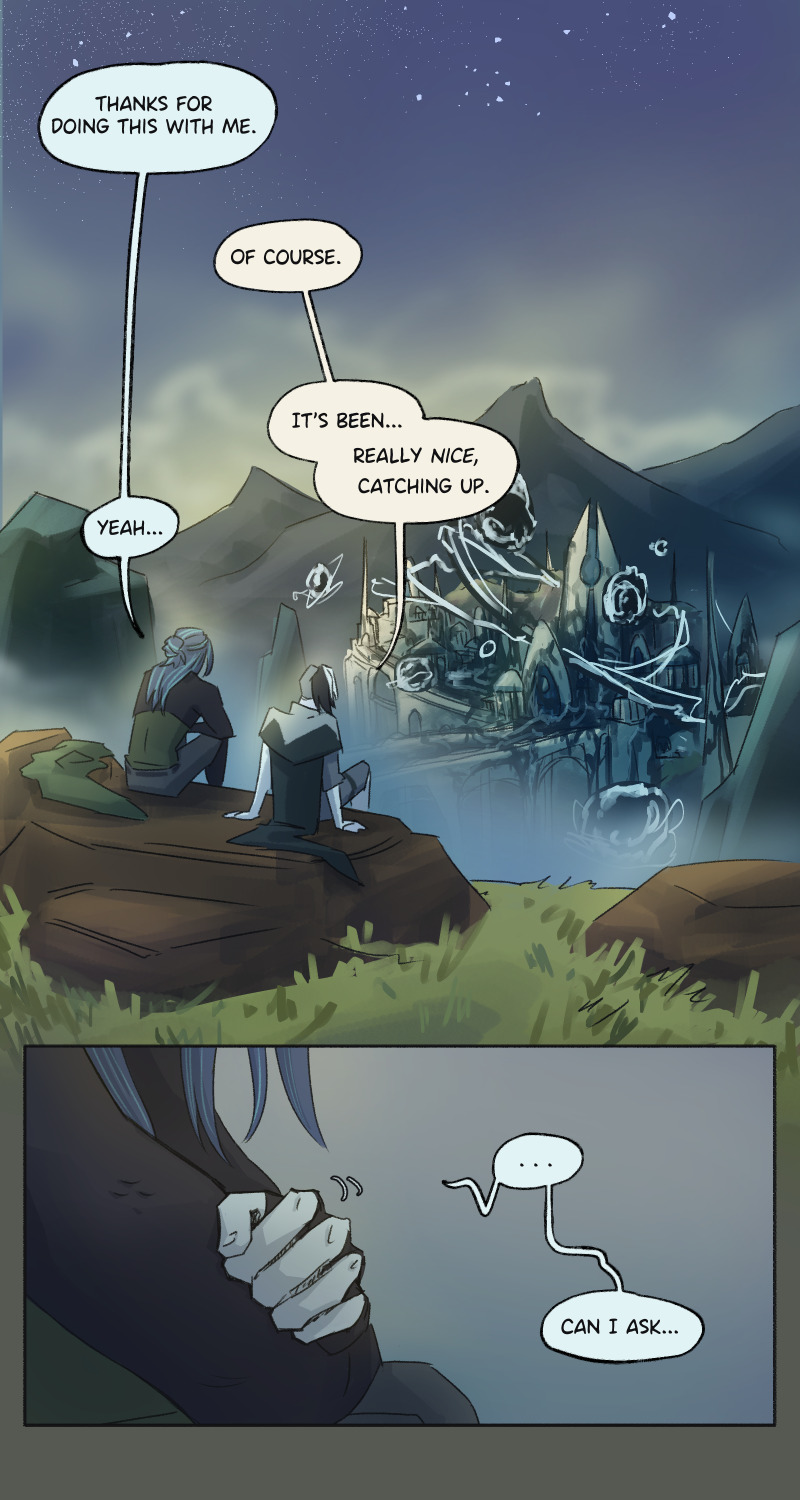

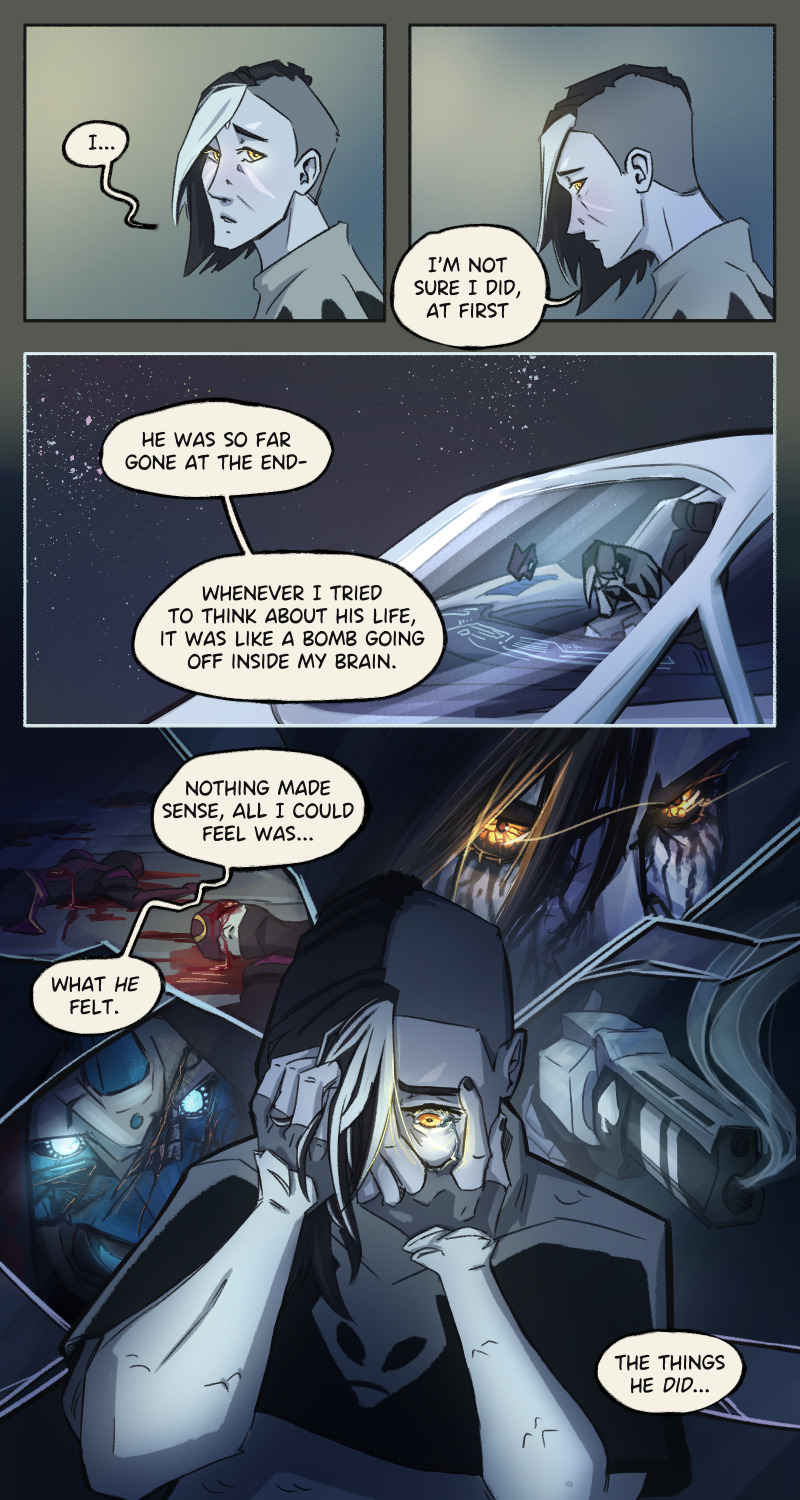

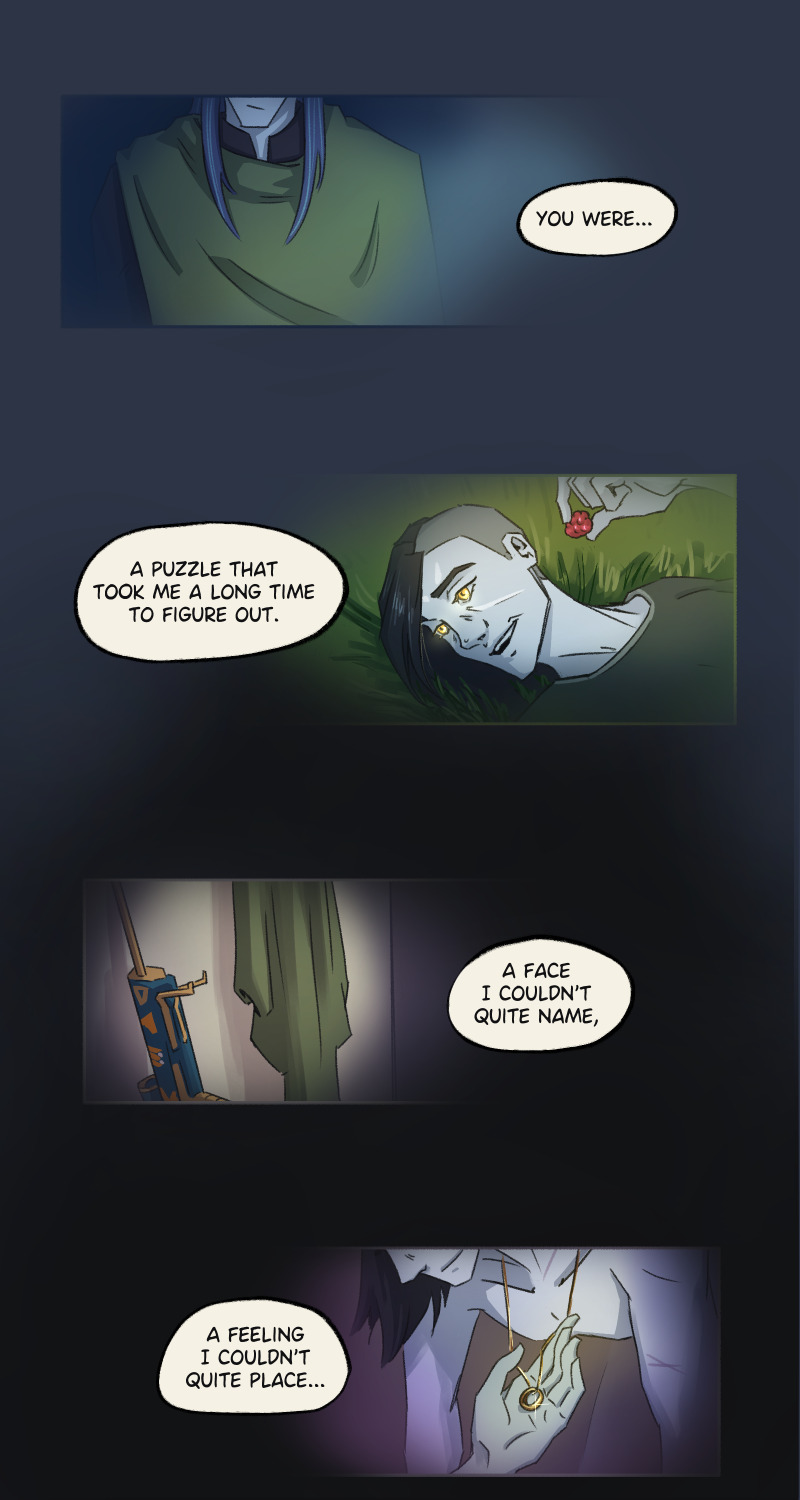
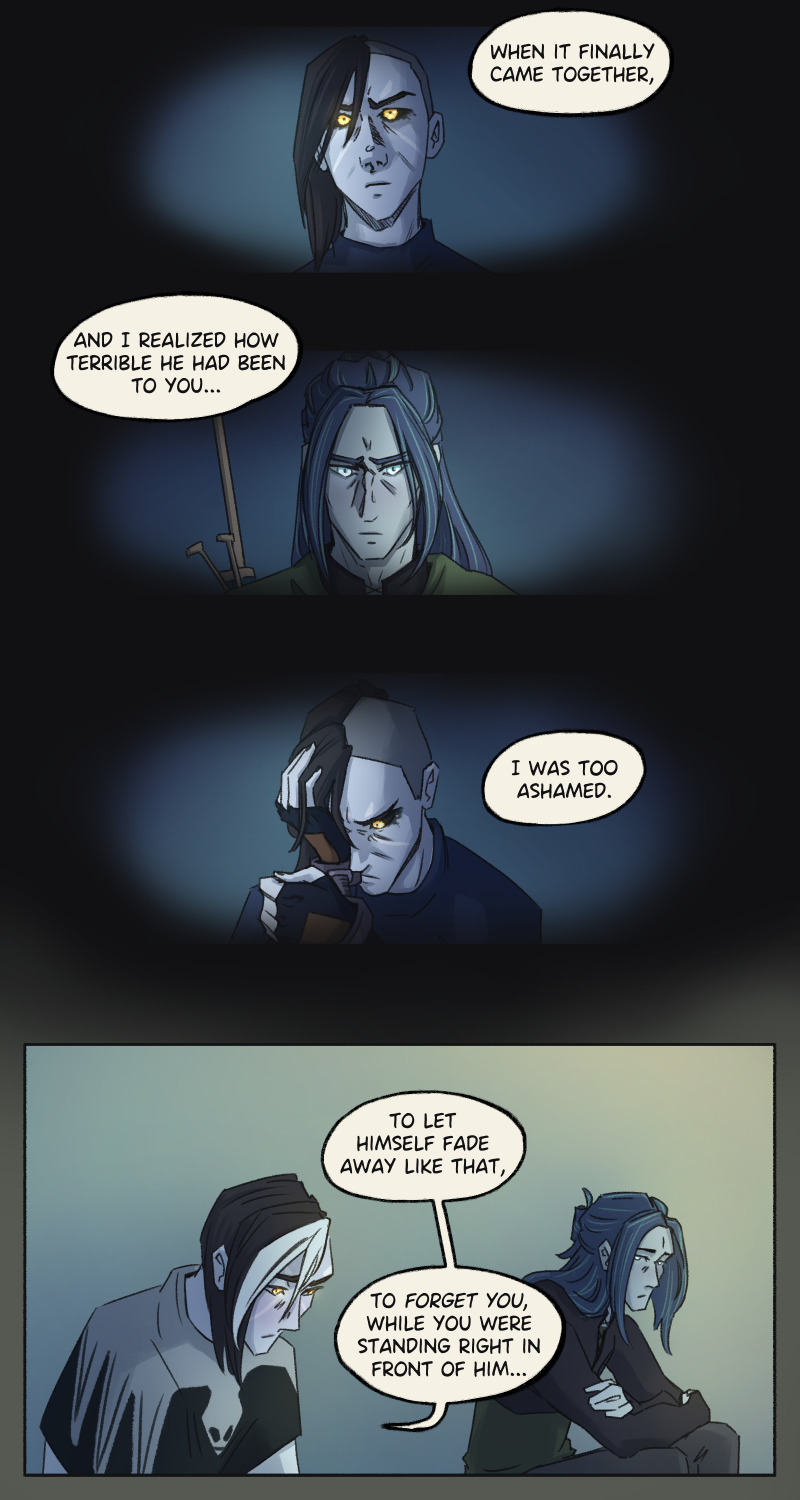
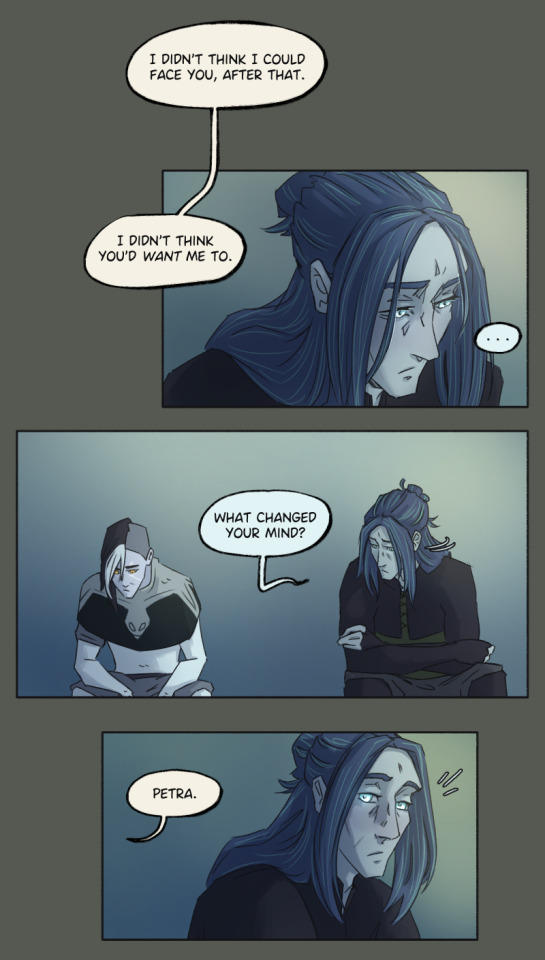
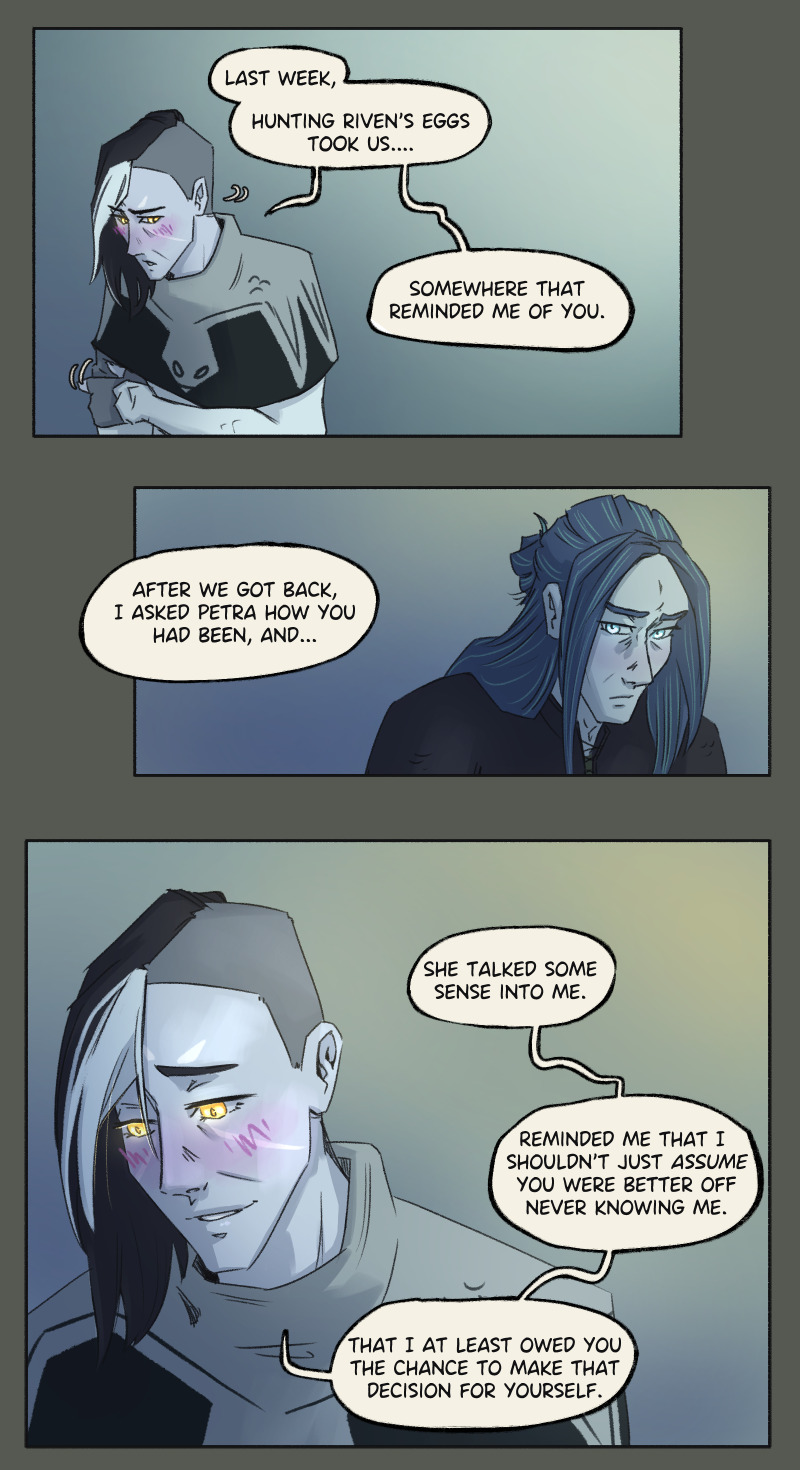
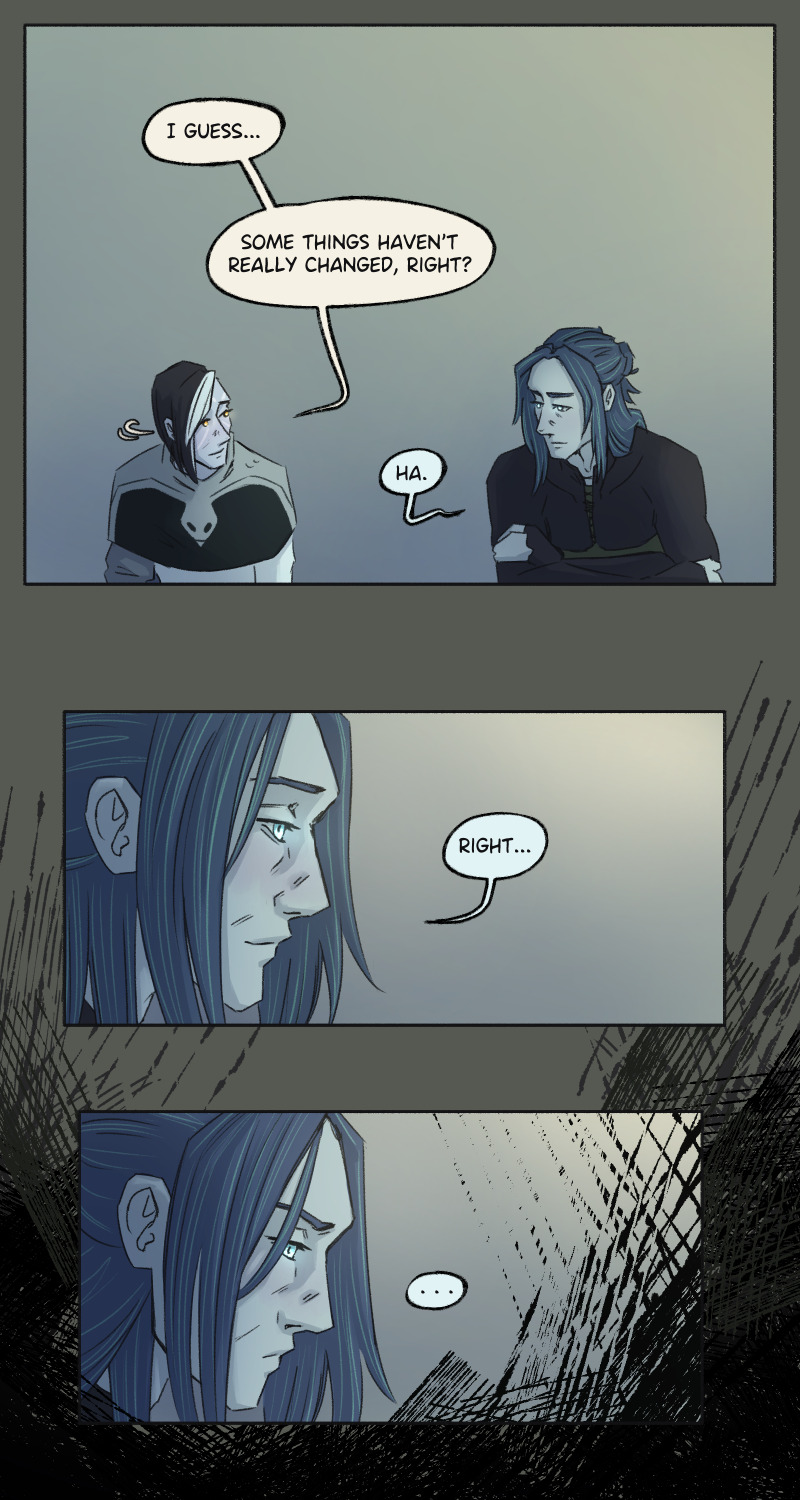

Part 6: The Summit Prev | Next (Soon™️) | Start
Two parts left! sorry to end on a lil cliffhanger of sorts. also sorry i'm going to continue to be very mean to jolyon. also also sorry i will not be finishing this before tfs launches lol 🥲
ID below cut like and subscribe etc
Panel 1: Wide shot of Crow and Jolyon sitting on a rock on the summit of a mountain, looking down at the dreaming city below. The sun is starting to rise over distant mountains, and the dreaming city is covered in taken essence, with black taken orbs hanging all around it. Jolyon is leaning forward with his arms crossed and his elbows resting on his knees, while Crow is leaning back on his hands. Jolyon: “Thanks for doing this with me.” Crow: “Of course. It’s been… really nice, catching up.” Jolyon: “Yeah…
Panel 2: Close up of Jolyon’s hand from the side. He is curling it into a tense fist where it’s resting on his bicep. Jolyon: “... Can I ask…”
Panel 3: Close up of Jolyon’s face in profile. He is staring straight ahead with a pained expression on his face as he speaks. Jolyon: “Why now?”
Panel 4: Side view of Crow as he turns to look at Jolyon. He has a curious expression on his face. Jolyon (offscreen): “A few years ago… I heard about what happened, with Savathun. That you had remembered your past life.”
Panel 5: Side view of Jolyon. He is turning away from the Crow, and his expression is not visible. Jolyon: “When you didn’t reach out… I guess I just assumed you hadn’t remembered me.”
Panel 6: Side view as Crow looks at Jolyon with a mournful expression. Crow: “I…”
Panel 7: Crow turns forward again, looking down at the ground with a sad expression. Crow: “I’m not sure I did, at first.” Panel 8: Flashback of the Radiant Accipiter, idling in empty space. Crow is visible through the windshield of the ship, he is hunched over in the pilot’s chair with his head in his hands while glint floats beside him. Crow (Present day): “He was so far gone at the end - whenever I tried to think about his life, it was like a bomb going off inside my brain.”
Panel 9: Close up of Crow looking down past the camera. He is clutching his face with both hands, one hand is tearing desperately at his hair while the other is covering his cheek, nose and mouth. He has a horrified, distant expression on his face, and a tear is running down his cheek. In the background, a cracked surface shows many scenes from Uldren’s rampage. One fragment shows a close up of Uldren’s eyes as he turns towards the viewer with a hateful expression. Black rivulets of corruption are flowing from his eyes like tears, and the sclera of his corrupted eyes are black and seeping into the iris. Another fragment shows several dead corsairs lying on a stone floor in pools of blood. Another fragment shows a close-up of Cayde-6’s face, staring up at the viewer defiantly. His face plates have been badly damaged. The final fragment shows a close up of Uldren’s hand holding the Ace of Spades hand cannon, with smoke coming out of the barrel. Crow (Present day): “Nothing made sense, all I could feel was… what he felt. The things he did…”
Panel 10: A wide shot of Crow lying in bed, bundled up in his blanket. The room is dark, and a window is open, with bright sunlight shining in through the curtains. Crow (Present day): “But eventually…”
Panel 11: A close up of Crow holding Glint with one hand. Glint’s eye is closed, and he is humming gently. Crow (Present day): “I was able to start picking up the pieces.” Panel 12: Closer shot of Crow lying in bed. He is clutching Glint against his chest with one hand, rubbing his shell gently. With his other hand, he is holding a golden ring on a chain. He is staring blankly at the ring with a sad, tired expression. Crow (Present day): “To put together who he had been before.” Panels 13, 14, 15, and 16: A sequence of fuzzy, incomplete memories. The first is a shot of Jolyon in his uniform, from his waist to his chin. Most of his face is not visible, but he seems to be scowling. He is partially obscured by a misty, dark blue background. The second memory is a shot of Uldren lying back in green grass on a sunny day, eating raspberries. He is looking to his right, at someone just offscreen. He is laughing lightly, and looks peaceful as he holds a raspberry up to his mouth. The third memory is a shot of Jolyon’s dark blue Supremacy rifle leaning against a wall, next to where his green cloak is hanging. The fourth memory is a partial shot of Uldren resting on his hands and knees above Jolyon, who is not visible. Uldren is shirtless, and a golden ring is hanging from a chain around his neck. Jolyon’s hand is reaching into frame, holding the ring in his palm where it hangs. Uldren is smiling down at him warmly. Crow (Present day): “You were… A puzzle that took me a long time to figure out. A face I couldn’t quite name, a feeling I couldn’t quite place.”
Panel 17, 18, and 19: Another sequence of memories, which are more clear than before. The first panel is a head-on shot of Uldren, staring up past the viewer with a confused, strained expression. The scleras of his eyes are black, and the corruption is starting to seep out of them. The second panel is a head-on view of Jolyon, staring down at Uldren with an intense, searching expression. The third panel is of Uldren, who is looking away to scratch at his right eye with the heel of his hand. His hands are cuffed together at the wrist, and he looks frustrated, and distracted. Crow (Present day): “When it finally came together, And I realized how terrible he had been to you… I was too ashamed.” Panel 20: In the present day, Crow is leaning forward, and staring distantly down at the ground, while Jolyon watches him talk. Crow: “To let himself fade away like that, to forget you, while you were standing right in front of him…”
Panel 21: Close up of Jolyon as he looks away, and stares sadly into the distance. His brow is furrowed and he looks conflicted and tired. Crow (offscreen): “I didn’t think I could face you, after that. I didn’t think you’d want me to.” Jolyon: “...”
Panel 22: front view of Crow and Jolyon sitting side by side. Crow is leaning forward heavily, looking down at the ground with a grim, slightly frustrated expression. Jolyon is turning slightly towards Crow, though he is not looking directly at him and is expression is sad and distant. Jolyon: “What changed your mind?”
Panel 23: Close up of Jolyon’s face. He looks slightly surprised and is looking directly at Crow, offscreen. Crow (offscreen): Petra.
Panel 24: Shot of Crow as he hunches away from Jolyon, rubbing his right arm self-consciously. He is glancing out of the corner of his eyes back at Jolyon with an uncertain, guilty expression. Crow: “Last week, hunting Riven’s eggs took us… Somewhere that reminded me of you.”
Panel 25: Close up of Jolyon as he watches Crow out of the corner of his eyes. His brow is slightly furrowed, and he looks uncertain.
Crow (offscreen): “After we got back, I asked Petra how you had been, and…”
Panel 26: Close up of Crow. He is smiling lightly, staring down at the ground with a distant, soft expression and blushing faintly. Crow: “She talked some sense into me. Reminded me that I shouldn’t just assume you were better off never knowing me. That I at least owed you the chance to make that decision for yourself.”
Panel 27: front view of Crow and Jolyon sitting side by side. Crow is turning back towards Jolyon with a soft smile. Jolyon is also looking at Crow, smiling faintly. Crow: “I guess… some things haven’t really changed, right?” Jolyon: “Ha.”
Panel 28: Close up of Jolyon’s face from the side. He is staring straight ahead again, smiling faintly. Jolyon: “Right…”
Panel 29: Jolyon looks slightly down, his smile has fallen and his brow has furrowed as his expression grows distant. Dark, scratchy marks are bleeding into the edge of the panel, fading out the edges. Jolyon: “...”
Panel 30: extreme close up of Jolyon’s eye, squeezed shut. Dark scratchy marks surround the panel, creating a chaotic background and bleeding into the panel. Voice offscreen: “Jolyon…”
Panel 31: A younger version of Jolyon turns towards the camera from the side, with a confused expression. His hair is pulled back into a bun, and he is wearing a light green sweatshirt. The background is faded purples and blues, and Jolyon is outlined in surreal surreal shades of pink and purple. The panel is outlined by dark scratch marks, spiky thorns, and black flowers outlined in vibrant shades of pink, purple, and green. The text bubbles appear to be glitching out, with scratchy fragments coming out of them. Voice offscreen: “Why’d you do it?” Jolyon: “What?”
Panel 32: Shot of Uldren sitting on a rock, from behind. He is leaning forward, resting his hands on his knees, and staring down at the ground. His hair is falling over his face, and his expression is not visible. The surreal lighting continues in this panel, and Uldren is outlined in pinks and purples with the panel being surrounded by dark scratch marks, spiky thorns, and black flowers outlined in bright colors. Uldren: “Why did you come with us, Jol?”
#lol lmao 'last week' bestieeeee that was 6 months ago!!#& yeah im still fixated on that one mention of an unexplained ring uldren had from like 4 years ago. what of it#destiny 2#crowlyon#jolyon till#crow destiny#uldren sov#cw blood#cw hallucinations#me: im gonna keep this simple so i can finish this comic faster. also me: i can fit five whole panels into this one panel sick
340 notes
·
View notes
Text
The State Birds Initiative: Pennsylvania (#2)

Welcome to the second official poll of the State Birds Initiative! Before the poll, though, one thing real quick. My suggestion is that you read the post below before voting in the poll below. That's especially important if you're lacking any context about the birds being presented as the new (or old) State Bird of the Keystone State, Pennsylvania. This is to be fully informed as to why these are being presented, and to make your choices appropriately. Lastly, some of these birds, you will notice, may go against some of the rules listed in the introduction post. All is explained after the jump where the explanations are, I promise you that. But with that...OK! Here's the poll! More choices this time, but that's definitely a bit deceptive. Trust me, read the stuff after the jump, you'll see why.

LET'S GO PHILLY
Kidding on two fronts. One, not a massive sports fan, and not really a fan of any Philadelphia teams (I love Gritty, though. Always and forever.). And two, this is obviously not a post about Philadelphia. So, let's talk about the Quaker State, Pennsylvania! The capital is Harrisburg, while its biggest city is Philadelphia. Pennsylvania is, of course, the first capital of these United States, and arguably the seat of the country. It's the home of Benjamin Franklin (even though it wasn't his birthplace), the Liberty Bell, the Constitution, and Rocky Balboa. And of course, its perfect symbol: Gritty.

God, he's beautiful. The perfect mascot. Who cares about the Flyers; Gritty's who I'm rooting for. Anyway, amazing and unassailable symbols of chaos aside, we're here to talk about Pennsylvania's natural world. So, what are we looking at. Well, it's a mostly deciduous forest-dominated state, so we're looking at seasonal forests and probably seasonal birds...for the most part. At the very least, our ideal bird is a forest resident and breeder in the state. Nothing too unusual or difficult to find.
Birding in Pennsylvania is pretty stereotypical to that of the northeastern United States. There are a few major spots, especially those that graze the Appalachian Mountain Range, which runs through the state. As for conservation concern, habitats of focus are the Appalachian forests that are often deforested for development, especially in the areas near Philadelphia. No real surprise, but that's a good target for conservation focus.

As for Pennsylvania's culture, it's famously descendant of the Quakers, who founded the state under the leadership of William Penn. This isn't to say that Pennsylvanians are Quakers; if you've been to Philadelphia, you know that's not true. According to a few accounts I've seen, that essentially means there's an attitude of helpfulness to your neighbor within the state, as well as a cultivation of the value of hard work. It's also a state that prides its history pretty thoroughly, from Philadelphia's various museums and public historical monuments, to the historical communities that thrive in the state, like the Lancaster Amish. Not sure how either of those will translate themselves into birds, but...hey, we'll see, right?
I also saw somebody refer to PA as heavily into "snack culture". And I'm not entirely sure what that means, but I WILL take the opportunity to say one thing: do not waste money on the cheesesteaks at Pat's or Geno's. It's meant to attract tourists, and they aren't worth it, BELIEVE ME. There are better cheesesteaks in the city, from what I've heard, but those two are...not worth the money. Just trust me on this one.

That said, it's time to look for a proper state bird for Pennsylvania. There's some emphasis there on the "proper", and the first entry in the following section has an explanation by that. With that, let's go for it! State Bird nominations for Pennsylvania below the jump!

Ruffed Grouse (Bonasa umbellus)
OK, let's start with the current bird highlighted by Pennsylvania, the Ruffed Grouse (Bonasa umbellus). Now, I love these guys. If you've never experienced it, walking through the woods and suddenly hearing a deep thrumming echo through the trees is...it's a unique sensation. You wonder where it's coming from, why and how it's so loud, what's making it, and then...it just pops up. Maybe it sees you looking for it, and you flush it out and watch a panicking male run away. Maybe he just looks back at you puffed up and stands his ground a bit (which is unlikely, but still). Either way, these guys never cease to put a smile on my face.
This behavior is called drumming, by the way, as pictured above. A male grouse will position themselves on a hollow fallen tree, and use it as a megaphone to send out these vibrations across swathes of territory. It is, unsurprisingly, a territorial behavior for the grouse, and iconic in its own way. Now, a few more facts about the Ruffed Grouse. The name, by the way, comes from the feathers on the sides of the male's neck, which are erected during courtship and territorial displays. It's obviously colored to camouflage in the fallen leaves of deciduous forests, where it resides throughout the year. They're granivorous members of the Galliformes (grouse, pheasants, quail, etc.), and fairly common in the Eastern United States. But with that said...here's the big problem with this choice for State Bird.
It isn't a State Bird. It's a State Game Bird.

Yeah, remember the Delaware Blue Hen from the last poll (assuming you read it, here it is if you didn't)? I suggested that it should be the State Game Bird of Delaware, rather than the State Bird. Well, right next door to Delaware, Pennsylvania already has a State Game Bird in the form of the Ruffed Grouse. Why, you ask? Well, first off, the Ruffed Grouse is actuall known as the "King of the Gamebirds" colloquially, crowned such by William Harnden Foster, the father of skeet shooting. Yes, actually. But anyway, the bird was declared the State Game Bird in 1931, but there was not real reason why outside of popularity with hunters. So...OK, fair enough. It just means that the Ruffed Grouse is not a State Bird. But should it be?
The question asked here is, should the Ruffed Grouse be promoted to a State Bird, since most Pennsylvanians seem to think of it as such anyway? Well, looking at the guidelines we've previously set and established...I don't know, honestly. And my main reason for doubt, personally, is the fact that the grouse, while found in Pennsylvania, is BARELY a breeder in the state. Only 0.4% of the bird's overall breeding population is in Pennsylvania, and only 13% is in the United States at all. And yes, that means the species is mostly found in...

So, when you think about it, is this truly the answer to the PA State Bird question? Well, it does represent much of the biome of Pennsylvania, a forest-dominated state squarely in the temperate and deciduous zone. It has a history and culture of hunting, and the grouse is certainly one of the most popular species on that front. And they're certainly iconic, and easy to hear in most forests, not to mention fun to look and listen for for beginning birders. The first time I stumbled on a Ruffed Grouse was, lemme tell you, a delight. And the second time, I LITERALLY stumbled on them, because a mother and her chicks were running away from me, and one of the chicks ran between my feet from behind me to join its mother, and I have NEVER BEFORE FELT MORE LIKE A DISNEY PRINCESS UNTIL THAT MOMENT IT WAS FUCKING MAGICAL
But, yeah, with that said, I submit the Ruffed Grouse for your deliberation as a State Bird. And as for a State Game Bird...oh, I've got a thought on that one, too. But I'll save that until the end, I think.

Scarlet Tanager (Piranga olivaceus)
So, as before, let's start the replacement options with a bird suggested by the Cornell Lab of Ornithology, and a solid-ass pick for a number of reasons. The Scarlet Tanager is one of the most striking birds in the eastern United States, and there's no state with a larger breeding population of these birds than Pennsylvania. 13% of the species' global breeding population is found in PA, making the state a major staging point for the species. Native to and dependent upon the deciduous forests of the state, this is a hidden ornithological icon.

Chestnut-sided Warbler (Setophaga pensylvanica)
Well, if I had the Ring-billed Gull (Larus delawarensis) listed for Delaware, it only makes sense to list the Chestnut-sided Warbler (Setophaga pensylvanica) for Pennsylvania! Similarly, it's the only species that have Pennsylvania as a state in the species name. And trust me, this is a rare luxury, either because most states have no bird species named for them, or a LOT of bird species named for them. Just wait for the Carolinas or California, believe me. But that said, is the Chestnut-sided Warbler a good fit for Pennsylvania?
Well, it certainly breeds in the state; the majority of the global population breeds in Canada, like the Ruffed Grouse, but a good amount still breeds in the deciduous temperate forests of the USA. The PA breeding population represents 3% of the global breeding population, and as compared to Michigan's 7%, Pennsylvania still doesn't have the majority. But again, let's put that statistic to the wayside. Is there anything else about the Chestnut-sided Warbler that represents Pennsylvania in a meaningful way? Well...no. Not, not really. There is a story of John James Audubon (yes, that Audubon, the racist one), and his first AND ONLY sighting of the Chestnut-sided Warbler, which took place in eastern Pennsylvania, alongside his hunt for the species throughout his life. So, hey, there's a tie. But other than that, this is another opportunity to choose an handsome looking bird that serves as a unique bird to look for for Pennsylvanians, any of whom can say, "Hey, I've seen that bird! Cool!"
...Wait, I just realized something about this category of choice. Pennsylvania has more species name reputation than I thought...indirectly. Hmm. Let's combine their entries.

Philadelphia Vireo (Vireo philadelphicus) Bonaparte's Gull (Chroicocephalus philadelphia) Mourning Warbler (Geothlypis philadelphia)
There are, in total, three species that are named after the great city of Philadelphia, Pennsylvania. And this is both the only one with the city name in its common name...and also the worst choice of the three. At least the Bonaparte's Gull (Chroicocephalus philadelphia) and the Mourning Warbler (Geothlypis philadelphia) breed in the state. And for the record, those are up for debate for this spot if anybody world prefer those go in there. But if those are better options (barely; both birds also barely breed in Pennsylvania), then why choose the Philadelphia Vireo?

Is it iconic? To birdwatchers, maybe, but mostly because it's a pretty difficult bird to get when you're starting out. I've seen them, but it's not easy to find them. And to the layman? It's a little green bird that lives in green trees. Oof. Hard sell for a state bird. At least Bonaparte's Gull (above) is visible on bodies of water, and a fairly common bird alongside being an unusual-looking gull for most people. Plus, hey, they're kinda handsome and cute in my opinion. What about the Mourning Warbler (below)? While also somewhat difficult to find by virtue of being a little green bird, has a notable and memorable appearance. But you could also argue that it belongs rightly to other states instead.

But the Philadelphia Vireo? Yeah, it's the worst candidate of the three, but...it's also the only warbler who once carried the name Brotherly-Love Vireo. Yeah. As in Philadelphia, the City of Brotherly Love? That is a good reason. However, you could argue that, given the fact that the work "philadelphia" is literally Greek for "brotherly love"...it's still a flimsy argument. But hey, I'd be remiss if I didn't include these guys on this list for State Bird, even if I...doubt they're gonna get any votes.

Pileated Woodpecker (Dryocopus pileatus)
For one of two conservation-related entries of this post, let's take a look at the Pileated Woodpecker (Dryocopus pileatus). Now, to get this out of the way, the Pileated Woodpecker is all over the Eastern USA. These big, crow-sized woodpeckers (and these guys are HUGE when you see them for the first time; love 'em) are a common sight in deciduous and coniferous forests (the predominant habitat in PA), and are most certainly breeders in Pennsylvania. They're iconic enough, fun to find, and can be detected through signs they leave in trees. Namely, of course, I'm referring to the nest hollows they make in trees for their offspring, as well as holes made to search for insects. But, OK, same question as always, why suggest it for the PA State Bird?
The pileated woodpecker, as the big bird it is, is an ecosystem modeler. What this means is, those holes they carve in trees are used by other species, including owls, squirrels, weasels, ducks, and various others that live in the same areas. Pennsylvania's wildlife isn't above using Pileated Woodpecker holes for their own uses, making the birds extremely important for other species. Ecosystem architects are not uncommon in nature. Most of your probably think of the American Beaver (Castor canadensis) or the American Alligator (Alligator mississippiensis) when that topic comes up, but there are many others. In ecology, there's a term for species that modify their environments in ways that become significant for the survival of other species. Because other species rely on them, they're referred to as keystone species.
Get it?

Pennsylvania is also known as the Keystone State. And, like beavers and alligators before them, woodpeckers are also keystone species. This isn't a commonly talked about aspect of woodpeckers, but the Pileated Woodpecker in particular is getting some recent attention as a keystone species. So, why not highlight this recently proposed classification and give the Keystone State a Keystone Species for its State Bird? It serves as a lesson in ecology for everyone, school kids or the uninformed, and it's a great way to make the State Bird about Pennsylvania's ecosystems. Conservation-focused, and an iconic species to boot!
Do I think the Pileated Woodpecker is the best species for Pennsylvania on it's own merits? I don't know, honestly. Like I said before, it's a fun-to-find iconic bird, it breeds in the state, and there's not real reason it shouldn't be the state bird. But I really like the idea of giving the Keystone State a keystone species, and not a lot of North American birds act in that role. If anybody has a better suggestion, I am all ears, but I think this one works pretty well. Plus, hey, there's only one woodpecker amongst the State Birds, which is a shame! Who doesn't love woodpeckers?

American Goshawk (Accipiter atricapillus)
For the other conservation entry of this list, we once again turn to a raptor, and a damned cool one at that. Previously referred to as the northern goshawk, the American Goshawk (Accipiter gentilis) is a silent and efficient predator. One of the most skilled forest flyers amongst the accipiter hawks, these birds specialize in rodents and birds that live in the trees, and are amazing at weaving through the understory to catch their prey. I adore goshawks, and they're honestly a bit terrifying. I used to work at a raptor rehabilitation facility which bred these guys in central New York, and they're beautiful and terrifying. Also, I've held one in a towel burrito, and that was a highlight of my life.
Now, with that said, the goshawk is barely found in Pennsylvania in recent years, although it used to be quite common. The Fish and Game Department, alongside Audubon, have this as a species of major concern and focus in Pennsylvania, despite (for because of) a very small breeding population. But there's a sad reason for this, making this a VERY good candidate for State Bird. See, in the 1900s, goshawks were considered pests, due to their love of chicken and wild game birds. Therefore, they were regularly shot, and Pennsylvania in particular offered rewards for their bodies.

By 1931, goshawk populations in Pennsylvania plummeted. This was also when the early 20th century environmentalist movements started, and this issue in particular was noticed by environmentalist and suffragette Rosalie Edge. To save hawk populations in Pennsylvania, she purchased a piece of land to bar the hawk-hunters on the property. This was called Hawk Mountain, and was founded in 1934 as the world's first raptor preserve. Yeah. Not only was it the first of these, but one of the first (if not THE first) created by a woman. Let's fucking go. Rosalie was a known bad-ass in conservation, and regularly did shit like this for what she believed in. An unsung hero of conservation and ornithology.
The hawk hunts ended alongside the Pennsylvania Game Commission in the 1950s, and raptor conservation continued on as a major movement in the state of Pennsylvania. Hawk Mountain in particular became a massive centerpoint of this, and today, it's maybe the most famous place in the United States to watch the annual fall and spring migrations of raptors. The raptor counts at Hawk Mountain Sanctuary are an annual bonanza, attracting birders from near and far. Haven't made it there yet myself, but it's on my list of must-bird locations. I implore you to learn more about this wonderful place. Check out their YouTube channel if you want to know more from their perspective! And it's all based on the impressive conservation story of the American Goshawk. I think that makes it a pretty goddamn good candidate for State Bird. Brings attention to conservation history, and on a major natural phenomenon that can be seen every year in Pennsylvania. Pretty goddamn cool.
The hell is even left after that? Well...

Wild Turkey (Melagris gallopavo)
OK, hear me out here. Of ALL the birds in the USA, if there is any state should have more federal recognition, it's the Wild Turkey (Meleagris gallopavo). It's the only bird that essentially has a holiday dedicated to it (OK, dedicated to killing and eating it, but you get what I mean). It's also, notoriously, the alleged runner-up for national bird, having lost to the Bald Eagle (Halieetus leucocephalus). To be fair, here, that's a potential urban myth, but an important one regardless, especially to Pennsylvania.
Other than this, though, everybody knows what a Turkey looks like. It's arguably one of the top 5 iconic wild birds of the USA, and is very common throughout the country. It is, in fact, found in every one of the Lower 48, and in Hawaii (introduced there). Not Alaska, though. Which is good, because frozen turkey is dangerous. Ha ha ha. But is that an argument for Pennsylvanis to have it as the State Bird, or even as the State Game Bird? Because that's also an option, for the record. I argue, though, that Alabama, Massachusetts, Oklahoma, and South Carolina already have it as a State Game Bird, which especially makes sense for Alabama, which is prime turkey-hunting ground. As is, for that matter, Pennsylvania. Turkey season here is longer than in most places, and according to HuntStand, it's basically a culture there in and of itself. So, yeah, appropriate on that front alone. But that said...Pennsylvania should own the turkey for one more important reason.

I mean...Benjamin Franklin. Come on. You gotta give it to Pennsylvania's favorite son. I've been to the Franklin Institute, I KNOW how beloved he is in PA. And Benjamin Franklin, famously, loved two things: wild sex parties with older women, and the Wild Turkey. AND I QUOTE:
For my own part I wish the Bald Eagle had not been chosen the Representative of our Country. He is a Bird of bad moral Character. He does not get his Living honestly. ...For the Truth the Turkey is in Comparison a much more respectable Bird, and withal a true original Native of America… He is besides, though a little vain & silly, a Bird of Courage, and would not hesitate to attack a Grenadier of the British Guards who should presume to invade his Farm Yard with a red Coat on.”
Now, contrary to popular belief, this is not Franklin saying the Wild Turkey should be the national bird. This is, instead, Frankling saying that he fucking hates the Bald Eagle, whom he sees as a lazy, thieving, selfish, disrespectful, manipulative asshole. So, yeah, in retrospect, not an inappropriate symbol for some parts of the country. But regardless, he's right about turkeys: they do not give a shit about your boundaries if you're on their land. Trust me, I live in an area of New England where there are some BIG fuckin' turkeys, and they WILL CHASE YOU if you mess with them. I SEEN IT

With that, though, I think we've covered the major candidates for the State Bird of Pennsylvania. Any I've missed or forgotten? Any suggestions you may have? I'm all ears! Make sure to vote, and come back for state #3: New Jersey. Which...I think a lot of us have thoughts on. Although, hey...I don't hate the State Bird. Well, as a bird, anyway; I'm indifferent to it as NJ's bird. More context next time, I promise.

See you soon, and happy birding!
#birds#bird#birding#birders#birdwatching#birdwatchers#black birder#state bird#state birds#united states of america#USA#state bird initiative#state birds initiative#pennsylvania#ruffed grouse#scarlet tanager#chestnut sided warbler#vireo#philadelphia vireo#gull#seagull#bonaparte's gull#mourning warbler#warbler#pileated woodpecker#woodpecker#keystone#goshawk#american goshawk#northern goshawk
127 notes
·
View notes
Text

Cooper's Hawk Accipiter cooperii
1/25/2023 Orange County, California
While you can't see the bird's face, which takes away from this photo's overall effect, I really adore this shot because of how straight-on the hawk is. It was directly above me when I took this, and I'm sure I about broke my neck getting it. This view gives a great look at the graduated tail feather lengths, which is a diagnostic trait for telling Cooper's hawks apart from sharp-shinned hawks!
#coopers hawk#hawk#hawks#bird of prey#birds of prey#raptor#raptors#bird#birds#wildlife#bird photography#nature#birding#birdwatching#my photos#kestrel speaks
111 notes
·
View notes
Note
talk shit about central Asian buteos to me 👀
STOP SPLITTING CENTRAL ASIAN BUTEOS. WE HAVE SPLIT ENOUGH SPECIES OF CENTRAL ASIAN BUTEO
one time a fellow accipitriforme identifier and Bird Knower said that we should lump every single altai region buteo into "steppe buzzard" and call it a day and while some may call that extreme, i think hes right.
I need you to understand the state of things. all of these shown below are considered different species. Most of them have range overlap. Most of them have significant morphological overlap and severe plumage variability. The only one exempt from this is rough legged buzzard, who is consistently identifiable and also my only hoe.



Common(Steppe) Buzzard, Upland Buzzard, Eastern Buzzard



Himalayan Buzzard, Long Legged Buzzard, Rough Legged Buzzard
I genuinely cannot tell you What they are even trying to accomplish with all the recent taxonomy fiddling there. I read a paper recently that a lot of the genetic analysis used to split/combine the species in this region may have been too overzealous and that the genetic differences they cited were within the range of variability in a species. I don't know nearly enough about this kind of analysis to say if that's correct or not so I'm just going to bitch about the current state of things.
Himalayan, (Mainland)Eastern and Steppe buzzards are morphologically identical and overlap in range but were split into different species because of [checks notes] vibes? I guess? Steppe got rolled into Common, but Eastern's outside of Japan are still considered a separate species. In my humble opinion the only way to truly identify an Eastern Buzzard is if it is actively in Japan. Otherwise it might as well be identical to Steppe's.
Himayalan Buzzards should not exist. They should not be a taxa. They are morphologically and genetically identical to mainland Easterns. Why were these split. Why do you hate me.
Upland Buzzards at least have morphological differences from steppe(plumage patterns, feathered tarsi), but I've also been told by people who did not elaborate that they have hybridized with Long Legged enough that it has actively begun fucking this shit up. I genuinely have no idea what to think about that, it haunts my dream like that one guy who told me dark morph Uplands sometimes have unfeathered tarsi and then ghosted me. I cannot find sources for this, but I also cannot find sources for a lot of Central Asian buteo things because there fuckin' aren't any. It's almost as bad as African Accipiters
Frankly Long Legged could be rolled into Steppe in my opinion but genetic analysis on this one says it is at least a little justified, even if identifying them makes me want to bite people. They get a pass for now but should stop looking exactly like light-morph Steppes
In conclusion

oh also fuck cape buzzards. they arent technically relevant but still. fuck them
82 notes
·
View notes
Text

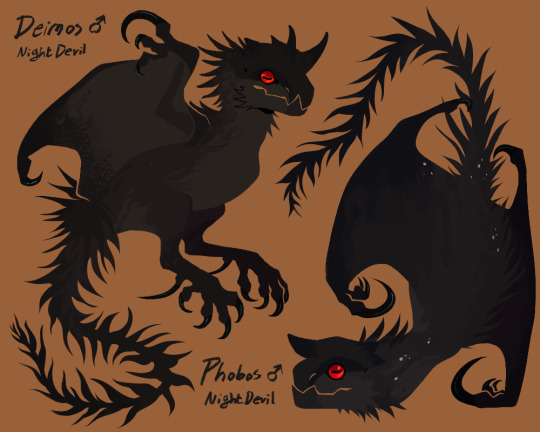

in the Vast Moor, the ruling system is fairly similar to other quivers; there's a leader –the Accipiter– and their second in command –the Noctua– but with the exception of having a third rank, the Corvus:
the Corvus has a practical role that borders on the religious. Wyvern training is incredibly important for moor runners, as such, it's obvious that someone who oversees that aspect would have a respected position of power. The Corvus is an influential advisor, playing a big role in the selection of future leaders, and is the one tasked to supervise all wyvern rearing in the quiver, being extremely knowledgeable on these creatures. Burials were another task traditionally assigned to them, but it wasn't until recently that they were allowed to do that again.
The reason for this previously mentioned prohibition is attributed to one dragon only: Shrikeshred
(cw for cannibalism mention lol) Shrikeshred is a controversial figure. Regarded as the Vast Moor's most talented Corvus in history –something clearly seen in her masterpiece book "Way of the shrike" which showcases her incredible wyvern handling abilities and techniques, some of which are still used today– that unfortunately took a turn for the worst. A famous cannibal, not much is known about what made her go off the deep end, though it is believed tensions with the Accipiter in her era and the lean times of winter season may have had something to do with it. After disappearing into thin air one day, her shadow is still cast over the foggy moors. How could anyone forget what she had done? There wasn't a Corvus for a long time, which proved detrimental to wyvern management in the quiver's territory. Some say she's still out there, waiting for the right moment to come back. The wyverns pictured here were Shrikeshred's favorites, all of them species considered untameable, especially the Death spitter, a dreaded wyvern that can spit boiling acid. So far she has been the first and only dragon to be able to train these species.
been wanting to post this for a while but i had to finish all the refs first 😭 if you're wondering why the style changes it's bc they were done months apart aheem. ANYHOW! im excited to do more pieces and comics revealing what actually happened with Shrikeshred, as well as other characters involved with that whole mess. Also here's some tiny bits of more info on her toyhouse
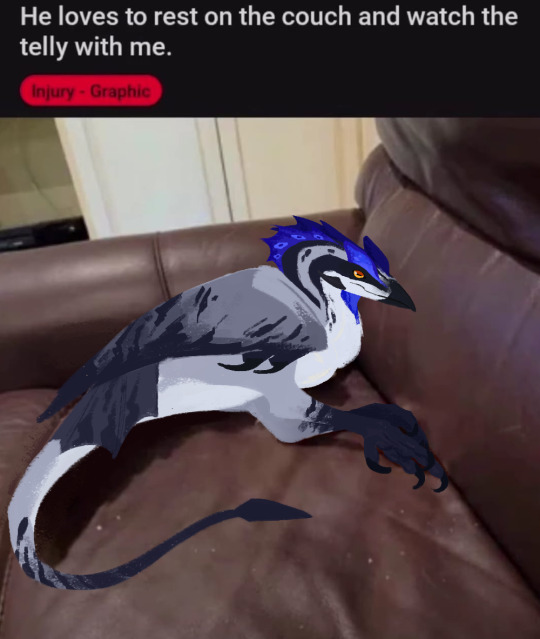
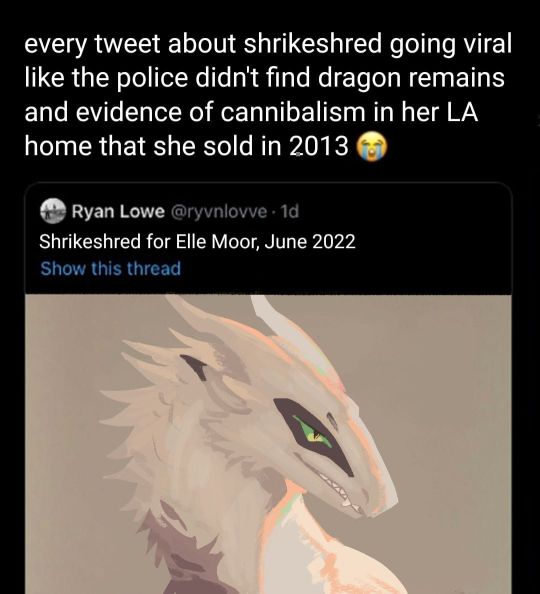
+ some silly posts
#wof#wings of fire#ashwing#art#my ocs#dragons#oc: shrikeshred#oc: deimos#oc: wolfsbane#oc: phobos#im so obsessed with her my horrible woman#she started with eating dead people and then she began actually hunting them which is why the funeral ban LOL#also a littledesign note she is BUILT compared to your average scrawny ass moor runner. like bigger and considerably more muscular#also i had to resume the corvus info from the doc theres a few details i missed but they aren't as important for now
178 notes
·
View notes
Text
under the radiant wings; guardian x crow
inspired by that hilarious exchange between Crow and Micah-10 about his Radian Accipiter :) and featuring my Hunter Cherish~ also on ao3
Among the many advantages of the Radiant Accipiter is the blissful lack of maintenance needed for the ship’s upkeep. Whatever may be needed, from oil change to part replacement, the link with the Traveler and the Light do it in an instant.
Crow is infinitely glad for that. As much as he loves tinkering, having a paracausal ship gives him little trouble in the downtime, which he may instead spend on Vanguard assignments or in the company of his friends or the Guardian.
Still, he rather likes having the ship stranded in the Tower’s hangar, shining its golden feathers on the ship’s outer shell. Every now and then it would catch an admiring eye - or a jealous one, depending on the day, and a myriad of questions comes to Crow from lightless mechanics to fellow Lightbearers.
That is, of course, when the ship is not taken out on missions by the Guardian.
When Cherish appears from around the corner, Crow knows exactly what he is about to hear. So he makes himself look busy, leaning over to check out some of the tools left at the mechanic’s station, and only finding it hard not to grin.
“Crow,” she announces on her approach, resting her hand on his shoulder. He does not flinch and turns to meet her eyes. They gleam with blue and jolly sparkle, something that he is getting used to seeing on his favourite Hunter’s face.
“Cherish,” he returns. She smiles at the sound of her name.
“May I take the ship today?”
Of course, these words would come back to bite him in the ass. Spilling it to Micah that he ‘allows’ the Guardian to take the Accipiter every now and then, betraying some amount of familiarity that exists between Crow and Cherish. A silly thought, and he has to remind himself often that everyone knows just exactly how much familiarity there is between the Hunter Vanguard and the Young Wolf.
And more than that, the strange implications around the ship’s ownership.
Crow turns to face Cherish, taking her hand off his shoulder and holding it instead, carefully avoiding the knife sheathed neatly on the underarm.
“And are you taking it far?”
“Haven’t you read my reports?” she blinks.
Crow rummages through his memory of the recent reports, finding none.
“Have you submitted any?”
When Cherish laughs, he has all the information he needs. She’s never the one for bureaucracy.
“You really hate reports, don’t you,” Crow smiles, following Cherish and her Ghost, Lux, to the ship.
The sun catches onto the feathers, reflecting the light. That is a beautiful sight and fills Crow’s heart with fondness and hope. This ship, and Cherish, have been the rare sources of laughter and smiles when his life was bound by grief and by the Spider’s ever present threat.
“I promise it won’t take long,” Cherish proclaims as the Accipiter’s airstairs drops from the ship’s hull invitingly. As she sits on the bottom stairs, so does Crow, inching closer to press to Cherish side by side.
“However long you need. But stay safe, yeah?”
Cherish rests her head on his shoulder for a moment. They share in it, in the quiet of the Tower, disturbed only by the occasional arrival of other vessels, and in the warm gentle sunlight of the eve.
“As always.”
“And if you need a ship to travel, you can always take mine.”
“That monstrosity?” Crow exclaims, laughing, pointing towards the spiky black ship in the other hangar unit, dark and menacing with its presence.
“Well, it does the job,” Cherish grins. “And looks good.”
“You look good.”
When she rolls her eyes, Crow kisses her cheek.
He knows she will keep herself safe. And the ship, and the whole galaxy, for such is the weight of the world on the Guardian’s shoulder. And if he has to give up the Accipiter for a little while, it is truly worth it.
#destiny 2#destiny 2 fanfiction#guardian x crow#yw x crow#young wolf x crow#the guardian#the crow#fanfiction#cherish#driftcreates
27 notes
·
View notes
Text


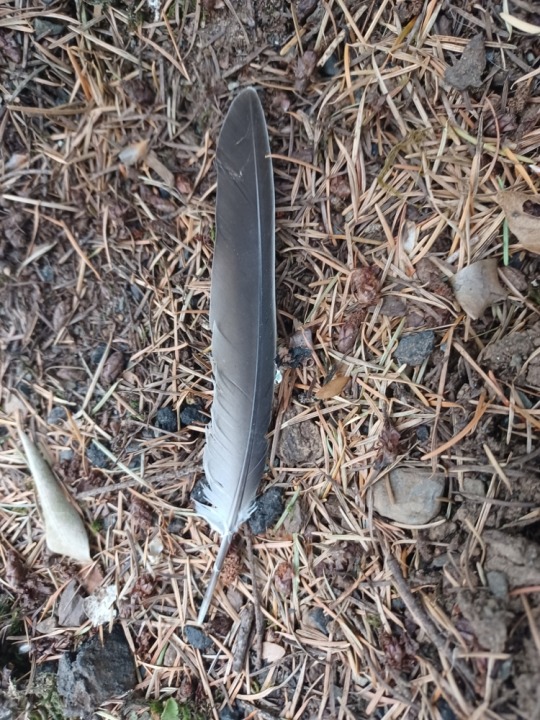
Over the long weekend, I taught a couple of my field classes. Sunday was the field portion of the two-day Nature Identification for the Amateur Naturalist class (the next session of which will be the first weekend in July, if you're interested.) Among the many other nifty flora, fauna, and fungi we observed, we also found some great feathers!
The first is from a Cooper's hawk (Accipiter cooperii) (likely juvenile secondary, according to the USFW Feather Atlas.) We actually got to see the bird that shed it, as a pair were courting far up in the trees above us--really cool to watch!
The second one is a turkey vulture (Cathartes aura) primary that some other park visitor had left tucked into the tree just so. And the third is a primary from some flavor of dove (Columbidae spp.)
It was a great opportunity to talk about how even though we may not observe an animal directly, we can still often find signs that they were there--feathers and fur, prints, scat, claw or antler marks on trees, etc. There is a lot of storytelling in nature interpretation, and these little clues are a great way to spark a tale of curiosity.
(Just as a reminder, it is against federal law in the US--the Migratory Bird Treaty Act--to possess the feathers of almost any wild bird. There's no way to distinguish a feather naturally molted, and one that was taken from a poached bird, so the law errs on the side of protection.)
#feathers#birds#wildlife#Cooper's hawk#turkey vulture#Columbidae#nature#nature identification#animals#science#conservation#ecology#biodiversity#Aves
182 notes
·
View notes
Text
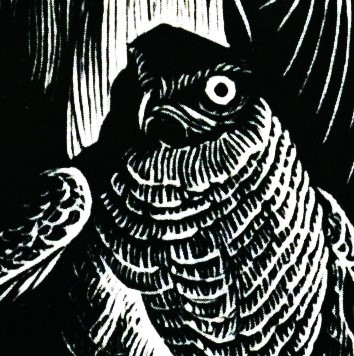


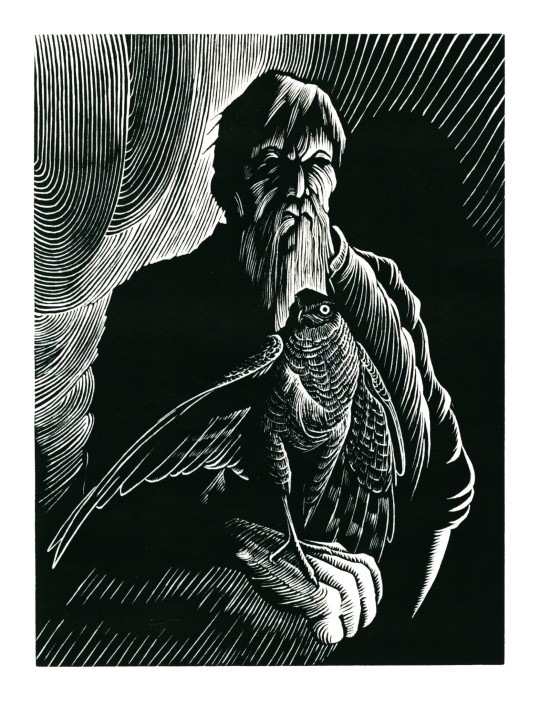
Another Wood-engraved Feathursday
JOHN MCWILLIAMS
Now here's a couple of intense fellows! The print is entitled Sparrow Hawk by South Carolina artist and engraver John McWilliams (b. 1941). The print was selected for inclusion in the Fourth Triennial Exhibition 2020-2022 of the American wood engravers society, the Wood Engravers’ Network (WEN), and this image is from the catalog for that traveling show.
McWilliams's work is inspired by Lowlands flora and fauna, so it seems a little odd that he would choose as his subject the Eurasian Sparrow Hawk (Accipiter nisus) rather than the American Kestrel (Falco sparverius), which is so common to his native habitat. Both species are used in falconry. Nevertheless, both offer something for the engraver, and we enjoy how McWilliams's Sparrow Hawk looks like it's about to take a bow.
John McWilliams received his BFA and MFA from the Rhode Island School of Design and is Professor/Director Emeritus of Georgia State University Ernest G. Welch School of Art and Design. He has received numerous awards, including the Guggenheim Foundation Fellowship and the National Endowment for the Arts Fellowship in photography. Today he maintains a studio in McClellanville, S.C. He counts as his inspirations the work of Albrecht Dürer and the German expressionists, the illustrations of Rockwell Kent, and the graphic novels of Lynd Ward and Frans Masereel. Of working in wood, he writes:
Woodcuts and wood engravings . . . have held much fascination for me. . . . The process of developing an image into a woodcut or wood engraving gives structure to my life. . . . It is such sweet irony that, although the act of creating gives my life structure, it nevertheless produces an enigma, a puzzle that others may interpret through their own lives. There are no easy answers. Such is life.
View more Feathursday posts.
View other posts with engravings from the WEN Fourth Triennial Exhibition.
View more engravings by members of the Wood Engraver’s Network.
View more posts with wood engravings!
#Feathursday#wood engravings#wood engravers#John McWilliams#Eurasian Sparrow Hawk#George Dirolf#Wood Engravers' Network#WEN#WEN Fourth Triennial Exhibition#exhibitions#exhibition catalogs#birds#birbs!
50 notes
·
View notes
Text
A Hawk’s Winter Watch
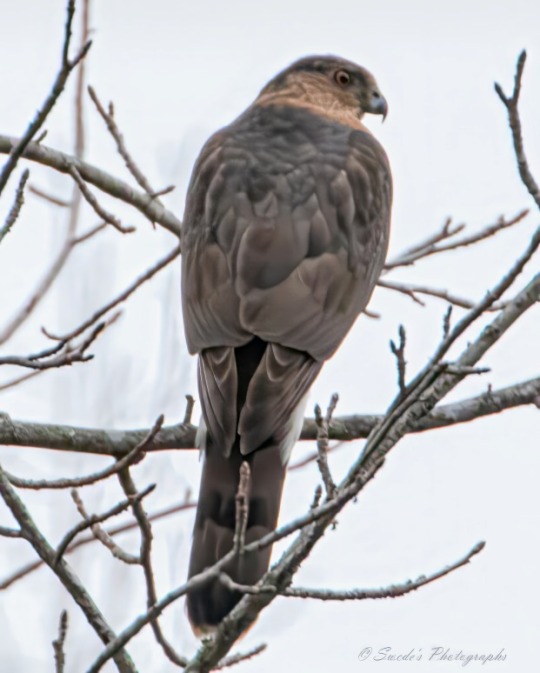
I looked out the back door this morning and this sharp shinned hawk (Accipiter striatus) high in a tall bare tree and the edge of the forest about 100 meters away. I grabbed my camera and went out in my slippers to get photos. I only went as far as the back fence. The morning is dark and cloudy, so the light was not optimal, and the bird was little more than a silhouette to the naked eye, but I still managed a halfway decent image.
'Backyard bird feeders do attract Sharp-shinned Hawks from time to time. Most bird watchers prefer to discourage this behavior, although studies indicate that feeders don’t greatly increase a bird’s chances of being taken by a Sharp-shinned Hawk—the hawks get the great majority of their diet elsewhere. If a hawk starts hunting regularly in your yard, the best thing to do is to take down your feeders for a couple of weeks.' - allaboutbirds.org
#photo#photography#photographer#photographylovers#birds#birdwatching#birdsphotography#birds of north america#birdlovers#birdphotography#sharp shinned hawk#raptor#hawk#birbs#bird#bird of prey#bird photography#bird watching#birding#birdingphotography#birds nature
41 notes
·
View notes
Text
Monarch: After Dark - Site Navigation Portal
Welcome once again to Monarch: After Dark, the digital gateway between you and the organisation dedicated to understanding and navigating this troubled new world we live in.
---
It's been a while, and we greatly appreciate the time you all are putting in to interact with our account manager with your questions and fun little jokes! That said, however, we have also noticed that the platform has become a bit overrun with questions and answers, and as a result, a lot of our actual work here has been buried.
Worry not, for we on the After Dark team are here to the rescue! This entry will serve as a committed navigation portal, of sorts, containing direct links to all our major entries for easier access! This entry will be pinned, and continually updated when new entries are created!
Without further ado, look below for all of our significant entries, sorted by category.

Category One: "Titan History" Series
All posts linked under this category are informational posts dedicated to specific Titans
Titanus Gojira (outdated)
Titanus Kong (outdated)
Titanus Jinshin-Mushi (M.U.T.Os)
Titanus Amhuluk
Titanus Scylla
Titanus Tiamat (outdated)
Titanus Behemoth
Titanus Na Kika & "Skull Island Kraken" (outdated)
Titanus Methuselah
Titanus Camazotz
"The Awakened Gods" (2019 Titan Roundup)
Titanus Rodan
Titanus Gojira & Titanus Kong (Godzilla updated, Kong outdated)
Titanus Mosura
"Monster Zero" (Ghidorah)
Titanus Abbadon (upcoming)

Category Two: "Superspecies History" Series
All posts linked under this category are informational posts dedicated to general superspecies from Skull Island and the Hollow Earth
Category 2A: Skull Island Fauna
Skullcrawler (Cranium reptant)
Mother Longlegs (Arachnida malum)
Leafwing (Icarus folium)
Psychovulture (Vultura insanus)
Sker Buffalo (Skerry bubalis)
Mire Squid (Gigantus leviapus)
Spore Mantis (Phasmid sylas)
Sirenjaw (Gigantus crocodiliad)
Death Jackal (Spinae mortem)
Swamp Locust (Stagnum acrididae)
Magma Turtle (Tortoisa vulkana)
Vinestrangler (Vitis strangulari)
Snarehunter (Cantus formica)
Spirit Tiger (Tigris spiritus)
"The Maritime's Bestiary" (Skull Island Fauna Roundup)
Category 2B: Hollow Earth Fauna
Warbat (Vellum vespertilio)
Hellhawk (Accipiter infernum)
Rockclaw (Saxum brachyura)
"Doug"

Category Three: Special Reports
All posts linked under this category are special news features the After Dark team put together, be they about how Monarch operates or other aspects of our shared world with the Titans.
The Titan Hunter
Defining a Superspecies
The Skull Island Survival Guide
The Lost Dinosaurs of Skull Island
Interview with Bernie Hayes

Category Four: Adventure Reports
All posts linked under this category are a particular variety of Special Report, where the After Dark team themselves are a direct participant in the action.
Janos Biotech Emergency Inquiry
The Dragons of Masca Bay
Roadmap of the Future
Category 4A: M.A.D. - Return to Skull Island
Mission Recruitment
---
We hope that this navigation portal will be of great use to all those who choose to engage with the After Dark platform in future! Keep an eye out for future entries to be added to the portal.
Until next time,
Monarch: After Dark
#monarch#monarch after dark#monsterverse#monsterverse au#godzilla#kong#titans#superspecies#blog navigation#link post#scylla#tiamat#abbadon#skullcrawlers#skull island#hollow earth
13 notes
·
View notes
Text
The State Birds Initiative: Connecticut (#5)
Hoo boy, it's been a minute! But hey, here we are again, after taking some extra time to figure stuff out. Welcome to the fifth official poll of the State Birds Initiative! Before the poll, though, one thing real quick. My suggestion is that you read the post below before voting in the poll below. That's especially important if you're lacking any context about the birds being presented as the new (or old) State Bird of the Nutmeg State, Connecticut. This is to be fully informed as to why these are being presented, and to make your choices appropriately. Lastly, some of these birds, you will notice, may go against some of the rules listed in the introduction post. All is explained after the jump where the explanations are, I promise you that. And apologies in advance, the spiel before the actual bird selection is...long. But with that...OK! Here's the poll!

Welcome to the Nutmeg State! A small state, mostly known for being between Boston and New York City, this is one of the foundational states of southern New England, while also having a somewhat...divided identity, we'll say. So, I grew up in CT, for part of my childhood, in both the classic upscale suburbs, and in the middle of the goddamn woods, right on the Connecticut River. For the record, the name "Nutmeg State" is based off of salesmen from the state known for peddling nutmegs. However, there's some speculation that the nutmegs sold were actually made of wood, but that's also probably from people who didn't know that nutmegs were supposed to be grated, and instead assumed they had to be cracked like walnuts. They tried, that failed, and they accused Connecticut Yankees for selling fake nutmeg as a result. So, yeah, a confusing legend at the root of the state's nickname.
You'll notice my use of the word "Yankee" there. Well, despite New York's domination of the term, it should arguably be most associated with Connecticut. "Yankee Doodle" is literally the state song; people from CT were previously and historically referred to as Yankees (which was also an epithet applied to northerners in general, to be fair); and it's actually possible the word was first used by the Dutch in reference to Connecticut settlers, according to multiple theories and historical references. But maybe most prominently, Yankee was used as a demonym for people from CT by one of its most favorite residents: Samuel Clemens, AKA Mark Twain.

Twain is, of course, Connecticut's most famous author, having written some of his most famous works while living with his family in Connecticut in his West Hartford house (which every central Connecticut middle school kid has been to at least once, I guaran-goddamn-tee it). Fun fact, though! Did you know...uh...ah, fuck it. Why keep stalling at this point? Look, as much as I love talking about Mark Twain, he was nothing to do with this post. Fact of the matter is...this was a hard one.
Look, I love Connecticut. It was the first state I remember living in, having moved there when I was a kid from the United States Virgin Islands, which I had been really looking forward to for a bunch of reasons. Admittedly (and unsurprisingly), a lot of that was because I was looking forward to seeing the birds! As a kid, I was also obsessed with birds, and I had never seen the birds in the US mainland before. It was an exciting time for me, and I honestly enjoyed growing up in CT, for the most part. I'd be there for almost 6 years of my life, and I have a lot of fond memories of the state. But, uh...ironically enough...finding State Bird nominees for Connecticut has been HARD AS HELL.

We will, of course, talk in GREAT detail about the American Robin (Turdus migratorius), as it's an important bird for more states than just Connecticut, but I'll give you a spoiler now: this is a boring choice for a State Bird. For any state. Don't get me wrong, I love robins! They're an extremely charismatic and iconic bird, and everybody has seen them at least once in their life if they live in the USA. They're also most likely an early bird (pun slightly intended) for people to encounter on a personal standpoint. Again, we'll get to them, but they're a notable entry in this list. And if one of the states kept the American Robin, I would understand. But, uh...is that state Connecticut?
OK, let's look at the state in the same vein as we have others. I'm sure this won't be the last difficult state to examine in the future of this project, so why not do the same here? Starting with habitat, Connecticut is another state placed within the Northeastern Coastal Zone, with a ton of deciduous forests dominated by oak, chestnut, hemlock, and white pine. There was a lot of clearance during early settlement and beyond, but succession has taken over in recent years to grow the forests back. The state's cut in half by the Connecticut Valley, with large floodplains dominated by maple and cottonwood, with the large Connecticut River right in the center of the valley. Finally, the Berkshires in the northwest corner of the state give us some classic New England flair with sugar maple (Acer saccharum), ash, beech, birch, oak, and hemlock trees on higher-altitude slopes, creating a hilly area that turns beautiful colors in fall. Man, I love Connecticut autumns. And the rest of the year, for that matter.

OK, what are Nutmeggers most known for, culturally and historically? It's a diverse state with a lot of mixed culture, partially as a result of its proximity to New York City. A lot of people tend to joke that Connecticut is just New York City, especially people from elsewhere in New England. And having been to NYC a lot when I was a kid, with a mom who worked there part of the week, and an aunt who lived there all of the week...yeah, fair. But Connecticut has a much more detailed culture than that. It's the home of the cotton giiiAAAAAAH, bad place to start that list. Uh, let's see, it's the home of whaliiiiiiing. Jesus. Uh...home of Mark Twain and Harriet Beecher Stowe? OK, that's better. It's a major seat of the Industrial Revolution in the United States, leading to it being a production hub for textiles, clocks, typewriters, machining, sewing machines, steam engines, aircraft, and honestly, women's rights to a certain degree. After all, it's the home of the Radium...Girls. Huh. OK, CT's history has some bumps in it, but what state's history doesn't?
As for modern Nutmeggers, they're industrious, generally well-educated, and honestly quite a bit eccentric. I've gone back to the state a few times in the last couple of years, and I forgot how honestly weird people are there. In a good way, not in the fucked-up MAGA sense of the word. It's a state whose people are unafraid to express themselves, from my experience. Probably a result of the diversity in the state, and the diverse perspectives that result. Its political atmosphere is a bit complicated, but overall pretty liberal. Which...doesn't translate super-well into birds at first blush, but hey, we'll see what we get!

OK, with that, let's jump into the selection of the birds for this list. Real talk, if anybody has a suggestion that I hadn't brought up here, send it my way! I will absolutely add another poll if there are entries I think could bear fruit. But, in the meantime, read on if you're interested in the possible choices for the State Bird of Connecticut!

American Robin (Turdus migratorius)
I think you'd be hard-pressed to find an citizen of the United States of America who hasn't seen a robin. This is, by far, one of our most iconic songbirds, and is certainly one of the most common and widespread. For some of us, they're a sign of spring. For others, they used to be a sign of spring, until global warming prompted some individuals to stick around through the winter, shifting their diet to frugivory a bit more and brightening the snow as well. They're prolific breeders with bright blue-green eggs (which are iconic in their own right), and can have up to three broods in a given season! Extremely successful and very common. And that...is a problem, for our purposes.
See, Connecticut, Michigan, and Wisconsin have the American Robin (Turdus migratorius) for their state bird, and none of them actually have a good reason for that choice. In Wisconsin, it was chosen by schoolkids because it was recognizable. That was also the reason for the Michigan Audubon Society to choose it as state bird. And Connecticut? Absolutely no goddamn idea. It's almost certainly for the same reason, but there is no real recorded reason for the choice of the American Robin as a state bird, as far as I can tell. For literally all of those states, it's a pretty bad choice by virtue of not being a good choice, at the very least. But that said...I mean, it's not the worst possible choice for a State Bird. For one state, anyway.

Robins, for the record, were named after a different robin entirely: the European Robin (Erithacus rubecula). Another red-breasted and beloved songbird, the European Robin was an immediate thought when American settlers saw the American Robin, hence why I keep saying "American". The two are so often confused in pop-culture, even Mary Poppins was guilty of it! That GIF above comes from the film, and in case you haven't realized it yet, that's an American Robin in England. Yeah. Wrong bird to use as a model for your animatronic, Disney. That has bothered me since I was a little kid, I swear to GOD. Erroneous film biogeography is one of my biggest pet peeves...but that's a separate conversation.
Back to the American Robin. Personally, I love robins of all species, and even recently did some genomics work with them (DNA extraction is fun). They're a commonly seen species, and a great entry-level bird for kids to get into birdwatching and nature. As an American icon, I genuinely think these guys should get some recognition...but I'm hard-pressed to say Connecticut needs them as a State Bird. We'll see what people think, but there's not a great case for them to get the title. To keep it...like I said, we'll see. Maybe the others won't be deemed as good a fit for the state. For now, let's move on from a popular backyard bird to a MUCH less popular one.

Blue-winged Warbler (Vermivora cyanoptera)
Here's the eBird pick for Connecticut, and for good reason! The vast majority of the Blue-winged Warbler's (Vermivora cyanoptera) breeding population is in...Wisconsin. Wait, what? Hold on...yeah, actually, Wisconsin, New York, Missouri, Ohio, Pennsylvania, and West Virginia all have higher shares of the population that Connecticut, with 5% overall. That's still a lot better than the American Robin's share in CT (0.2%), but still...seems like that eBird article is SEVERELY outdated, or I'm using the database wrong somehow. Either way...huh. Well, let's make an argument for the Blue-winged Warbler, anyway.
Blue-winged Warblers are a species of some conservation concern, making them automatically of interest. They're also extremely interesting to geneticists and ornithologists because of their relationship to other members of Vermivora, especially the Golden-wined Warbler (Vermivora chrysoptera) and extinct Bachman's Warbler (Vermivora bachmanii), with having documented hybrid offspring with the former that's of interest for various reasons. But outside of that, they of course breed in Connecticut, and represent an interesting bird to look for and find, with a recognizable song and appearance. It's also prized by birdwatchers, and would be a good bird for any aspiring or experienced birdwatchers. It also inhabits shrubland, which is of some conservation interest to CT government and environmental officials. But other than that...not too much else.

Connecticut Warbler (Oporornis agilis)
No. Look, I'm just gonna say this now: no. The Connecticut Warbler (Oporornis agilis) not only doesn't breed in the state (and possibly has never bred in the state), but it's pretty much not found there. Like, at all. This is not an easy warbler to get anywhere in its range in the US, but Connecticut isn't included in that distribution. "But lonelywretch," you scream at your computer screen, "why is it called the Connecticut goddamn Warbler if it isn't even from the state?" First of all, not to police your emotions, but stop screaming; way overboard for this situation. Second of all, it's called the Connecticut Warbler because its describer, ornithologist Alexander Wilson, first saw it in a fly-by during migration while in Connecticut. And...yeah, that's it. They do fly through the state very occasionally during migration, but it's definitely not a reliable bird to count on for local birders there. Honestly...bad bird for the state.
Side note here: there's a lot of talk about renaming birds that are named after people, and I agree with that in almost every case. But here's a hot take to elaborate on in another series: location-based names need to be re-examined. Not all of them are bad by any means, but the Connecticut Warbler is a great example of a bird whose name makes NO FUCKING SENSE. Rename this bird, I BEG of you. If anybody has suggestions for a renaming of this bird, throw them in notes for something! Keep in mind, Gray-headed Warbler is taken (by Myiothlypis griseiceps), so come up with somethin' else. Warranted inclusion in the list for its name, but we're gonna move on.

Osprey (Pandion halieetus)
It's at this point in the list where we get into some interesting candidates...and where I had the most trouble. But I'm fairly satisfied with what I've come up with, so let's move forward! This entry's a somewhat controversial pick for a few reasons, but an interesting one for a bunch of reasons. Now, I don't know about you, but I love Osprey (Pandion halieetus) a whole bunch. An iconic raptor, as well as a very unique one, they're a pescivorous bird found throughout the entire continent. And in Europe. And Asia. And Africa, Australia, and South America. Yeah, they're a cosmopolitan species, found in every continent except for Antarctica. That automatically should make them a bit dodgy of a choice for a State Bird, since they can be found in every state (yes, even occasionally Hawaii). So, why Connecticut?
First off, Connecticut has an intimate connection with the shore and rivers, especially the Connecticut River. Seemingly a loose reason, but the Osprey, AKA the river hawk or sea hawk (we'll get to that later) is an iconic riparian raptor, and a common sight in Connecticut. Having grown up on a river in the state, we used to see Osprey all the time, and it was awesome every time. But their commonness in the state is an important story in and of itself. And, if you know anything about Osprey at all, you know where this is headed. And Connecticut is a great example of this story.

The Osprey is one of the most iconic victims of the DDT crisis that hit the country, as well as a symbol of the environmental success story that resulted from its banning. I won't go into the full story if you haven't heard it, but the short of it is that the pesticide DDT was inadvertently ingested by fish-eating raptors, especially the Bald Eagle (Halieetus leucocephalus) and the Osprey, causing the eggs they laid to have weakened, soft shells. This caused a massive decrease in these and other species, nearly driving both into extinction. However, once environmental movements prompted by Rachel Carson and her book Silent Spring advocated for its eventual banning, the populations recovered. And in Connecticut, they've recovered A LOT.
In 1940, somewhere near 1,000 nests were recorded for Osprey between New York City and Boston. By 1970, the number in Connecticut was down...to 8. Jesus Christ, that's a hell of a crash! One of the worst in the country, in fact. However, today in Connecticut, there are 688 active nests in the state. Which, yeah, doesn't seem like the ultimate success compared to previous, but what's interesting is the rate of increase. Because in 2014, according to the Connecticut State Audubon, there were only 210. In ten years, the number of breeding ospreys known was more than tripled. That's incredible. This has quickly made the Osprey a symbol of conservation in the state, because of a massive amount of monitoring increase. There are states with more of a population, but Connecticut has a pretty good argument for having the Osprey. But that said...other states could also claim this species. Florida and Maryland definitely have claims on it for population size alone, not to mention, well...the most iconic state of all when it comes to having ospreys as a symbol. But we'll get to that one WAY later. just keep that in mind before you vote for Connecticut to have the Osprey.

Sharp-shinned Hawk (Accipiter striatus)
The Sharp-shinned Hawk (Accipiter striatus OR Astur striatus as of recent taxonomic proposals), on the other hand, is another bird of interest. The smallest hawk in the United States of America, this already seems a fitting choice for one of the smallest states in the country. It's listed as endangered in the state, immediately making it of interesting conservation focus. The reason for this status is likely because of window-strikes, which are common for the species in Connecticut, meaning that there's some public outreach needed to protect it. Protecting the forests they nest in (which are in danger) is one thing, but putting up protective window decals to help the species is another. Definitely a cause for focus.
However, there is one...minor detail that makes this a harder fight for public opinion, as well as a potentially ironic one. This is the first species we've discussed whose diet is basically exclusively birds. If you're in the Northeastern United States, and you've seen a bird get attacked and taken at your birdfeeders, it's almost certainly this guy. Which is cool, and important for the species' survival, but the average person being asked to protect a bird that kills other birds, especially birds like the American Robin, is...a palpable irony. Granted, it genuinely needs protecting, and has monitoring programs in the state, and it is a genuinely interesting raptor! But, this is a slightly harder fight to win because of that noncharismatic factor. But hey, it's a cool bird in genuine trouble in the state, it's a scrappy bird for a small state, and it's an interesting species to highlight!

American Black Duck (Anas rubripes)
This is another difficult bird to fight for, but one that needs attention, for God's sake. The American Black Duck (Anas rubripes) is a rapidly disappearing duck species, and not for the reason you think. Let's get to Connecticut representation first. It was the first bird to be used for the Connecticut Migratory Duck Stamp in 1993, the first one issued for the state. It's one of the few states in which it breeds (although it's not the primary state of focus, detracting from its candidacy). And, it's a controlled bird by Fish and Game, meaning hunting of the Black Duck is extremely limited. There is, surprisingly, a point to that statement, but I won't be elaborating here. We'll see how the vote goes, and I'll address it in the Results post.
So, why is this a potential issue? Well, Maine and New York arguably should get this bird instead, as they have a higher population. And the breeding population of this bird is incredibly important to promote, because it's disappearing. Why is it disappearing? Well, some of you may have looked at that picture and asked yourselves: "Wait...isn't that just a female Mallard?" And the answer is, no! But a lot of people think that. A lot of birds think that. Mallards think that. Which means that hybrids between Mallards and Black Ducks are incredibly high. SO high, in fact, the species is being bred and hybridized out of existence! They're so similar to Mallards on a genetic level at this point, that they'll be subsumed if their individual populations aren't preserved. So, yeah, these guys deserve some focus. Do I think they're a great Connecticut symbol? Well, to be fair, the state is regularly assumed to be either greater New York City or greater Massachusetts by outsiders. And it's not; it has its own identity that deserves to be preserved for what it is. So, yeah, maybe a good fit for Connecticut after all.
Also, it's the state in New England with the highest proportion of Black Americans (yes, even more than Massachusetts), so...I dunno, that's also something? Probably not, but as a black dude that grew up in CT, I felt the need to bring that up.

Snowy Egret (Egretta thula)
OK, sing it with me now!
Yankee Doodle went to town, a-riding on a pony; Stuck a feather in his hat, and called it "macaroni"! Yankee Doodle, give it up! Yankee Doodle Dandy, Mind the music and the step, and with the girls be handy!
Ooh, that last line aged a little rough, but Yankee Doodle! The Connecticut state anthem! Yes, really. Most Americans in the Northeast know this song, but it's got a unique resonance for Nutmeggers, seeing as it was allegedly based on the son of a Connecticut mayor! The state chose it as their song in 1978, and it's been a beloved symbol ever since. But, for the uninitiated (and probably to most school kids like I was), there is one weird word in there that needs a little explanation: macaroni.

Now, this does not, of course, reference the easy cheesy favorite of every child (and college student). No, this is a reference to an old 18th century term for a form of fashion back in the day. It's what the 2000s called "extra", or bourgeious (pronounced "bougie", of course). Basically, it's somebody who dressed WAY over the top in high-designed clothes and accessories to the point of looking...well, extra. Another applicable 2000s term would be "metrosexual", I guess. The macaroni became a satirical character in British culture, and would later become another character known as the "dandy". It's sort of a class-related satire, to be honest. In any case, the macaroni was known for over-the-top fashion, including...wigs.
So, what does literally any of this have to do with the Snowy Egret (Egretta thula)? More than you'd expect, actually. First off, the egret has a pompodour-like crest of feathers that makes it look quite like a stereotypical macaroni, in my opinion. Secondly, it does breed in Connecticut, albeit extremely rarely, sparely, and barely. Its population in the state used to be a lot greater...until people came around and starting hunting it down. Why, you ask?

Let's just go ahead and call that macaroni now, while we're at it. To be clear here, quite a lot of birds were used in millinery back in the day, but the Snowy Egret (and the Great Egret (Ardea alba), for that matter) are special. Those long white feathery plumes were heavily prized as hat decorations, enough so that the species nearly went extinct from hunting them for the hat trade. As a result of that, people began to turn their eye towards conservation of the species, and the protection of birds in general. Two women, Harriet Hemenway and Minna B. Hall, got a group of women together to protect the birds. They rallied the troops, and their organization became fairly popular. Eventually when they sought to name it, they did so after one of the most famous ornithologists in American history at the time: John James Audubon. And from there...well, you can guess.
The Audubon Society is one of the premiere bird conservation organizations in the world, and especially in the United States, and is well-known to the public sector. And it was born right here in...Massachusetts. Oh. Wait, have I jumped the gun on this one? Maybe a little, yeah. But, in my defense, the macaroni is linked to Connecticut through its state anthem, and the Snowy Egret is linked to the macaroni, as mentioned. But, OK, maybe this is a better proposal for Massachusetts, not Connecticut. But, uh...there may be another contender. Kind of.

Tufted Titmouse (Baeolophus bicolor)
OK, here me out on this one. Look at this picture of a classic macaroni character (on the right, for the record). Does that hairdo not kinda look like the crest of the Tufted Titmouse (Baeolophus bicolor)? Like, just a little bit, at least? I dunno, I can definitely see it. But OK, outside of that, is there another reason for the Tufted Titmouse to be the State Bird of Connecticut? Well, they're extremely common, they've got some charisma to them, and they're definitely found breeding in Connecticut. But...I don't know. I think they're plenty charismatic, but I'm not sure that makes them a great contender.
Still...they should be represented somewhere, right? I mean, the species breeds entirely in the USA, even though it can be found in Canada as well. Plus, other than being very recognizable, they're also an easy bird to find and support with backyard birdfeeding. And, if you want a fun fact about them, they're prone to kleptotrichy. That means, they pluck the fur from mammals to use as insulation in their nests! Yeah! They actually pick the winter coat off of dogs, and use it for their nests! Adorable. But yeah, does this really count for a good State Bird of Connecticut? I doubt it, but I'll let you vote! And I swear to God, it better not be just because of the name that it gets votes.

There you have it. Some complex and controversial choices. I miss any that you think are a valid choice for the state? Do let me know, and I may just issue another poll if this one isn't good enough. We shall see. But, for now, I think it's time to move onto the next state. And lemme tell you, I'm real excited about that one, since...well, I live there! And I have some ideas, lemme tell you. And some people will...disagree with me. For sure. Anyway, see you next time in Boston, kid!

See you next time, and happy birding!
#bird#birds#birding#birder#birders#birdwatching#bird watching#black birder#state bird#state bird initiative#state birds initiative#birblr#birdblr#american robin#turdus migratorius#blue-winged warbler#warbler#connecticut warbler#osprey#long post#tufted titmouse#snowy egret#american black duck#black duck#birds of tumblr#poll#tumblr poll#blazed posts
60 notes
·
View notes
Text
Birds of Tsushima
The Ghost of Tsushima(2020), is a beautifully atmospheric action-adventure game set on the Japanese island of Tsushima, during the first mongol invasion of Japan.
Much of the game consists of riding one’s warhorse through the natural countrysides of the island. Many of the game’s mechanics rely on the natural environment of Tsushima to guide the player around the map. The most striking and prevalent in the game is the Golden Bird, which guides players to main plot objectives.
The Golden Bird is a real species, the Black-naped Oriole, and it is not the only one on the island. Most of the birds in this games are only a backround element, near unnoticeable to the player. But looking a bit deeper shows an impressive degree of for-thought put into the detail of each model. I have found a total of 12 real native bird species present throughout the island. And I am about to describe them all.
Each bird will have a game screenshot, a irl species photo, and a small blurb about the bird in-game, including where it can be found for the virtual-birding-inclined.
First up:

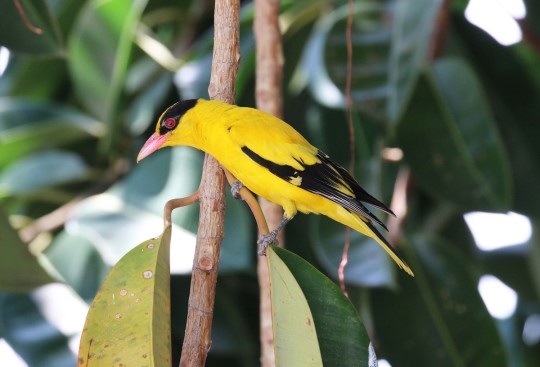
Black-naped Oriole Oriolus chinens
The so called "golden bird" is the main plot guide in this game and can be found at undiscovered points of interest.
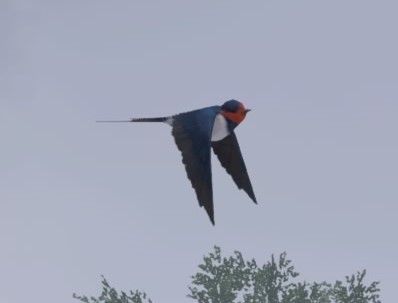

Pacific Swallow Hirundo tahitica
This bird swarms above Haiku spots in large numbers.
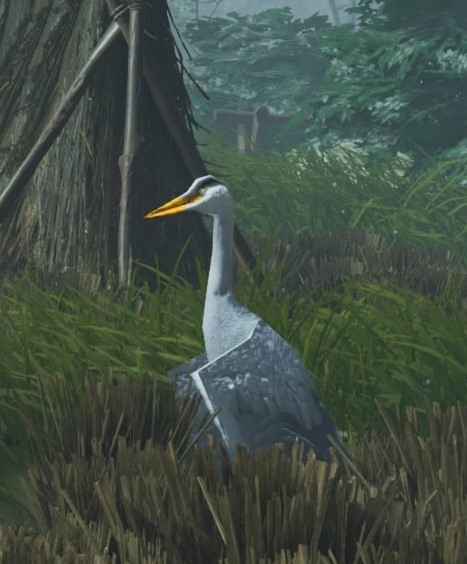

Gray Heron Ardea cinerea
This large wetland bird can be found at the farmsteads of Izuhara. This bird seems to share a model with the next entry.
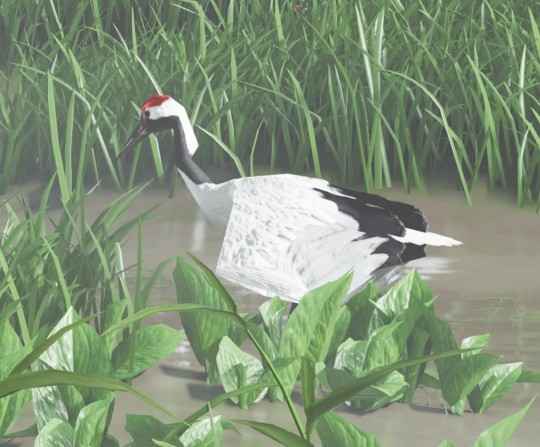

Red-crowned Crane Grus japonensis
These striking birds can only be found in the Old Togo Rice Fields, near Fort Ito. This species is often used to symbolize immortality and divinity in eastern folklore and religion.
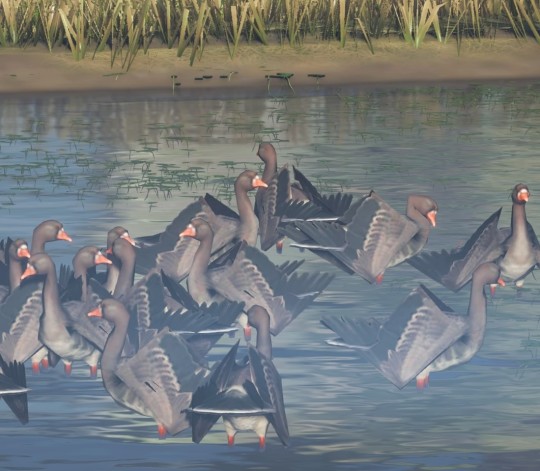
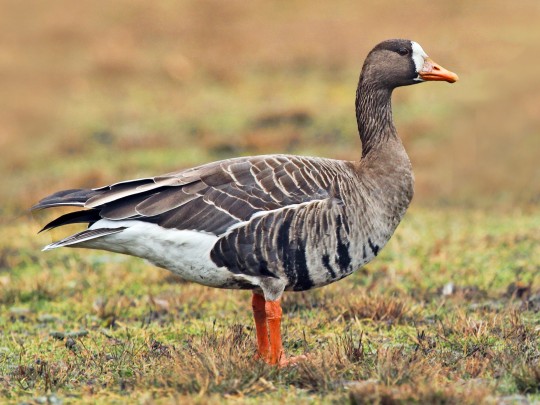
Greater white-fronted Goose Anser albifrons
These birds are easy to overlook and hard to approach but can be found by the Old Togo Rice Fields, near Fort Ito, pond near Numata Settlement.
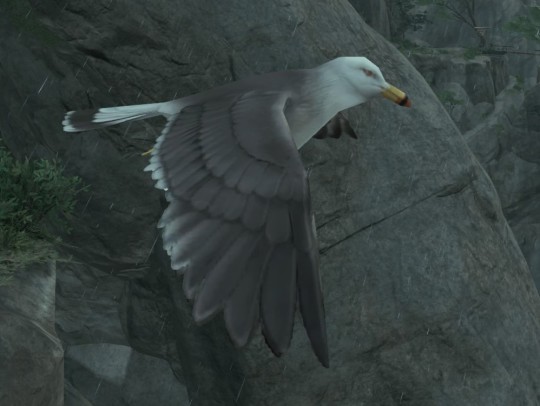
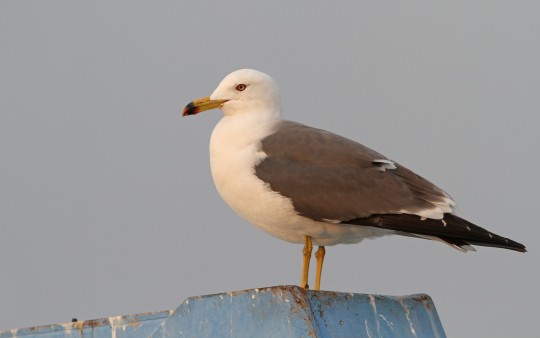
Black-tailed Gull Larus crassirostris
These birds can be found in multiple locations along the coastline, but i got the closest to them at Mending Rock Shrine.


Eurasian Sparrowhawk Accipiter nisus
These birds are used as messengers by the defending Japanese forces and can be found as plot objectives at select mongol bases. The model seems to be the male form of the species.


Golden Eagle Aquila chrysaetos
Golden Eagles are not a native of Tsushima island, but are heavily used in traditional Mongolian falconry. In the game, you will often come across them as in Mongol scouting parties. Fun fact, if you kill the handler of these birds instead of the birds themselves, they will sometimes come and perch on the body. Great for photo ops! But quite depressing.
Additionally, these birds are traditionally used to hunt small animals such as red foxes for pelts. Suitably symbolic for the island’s sacred foxes.


Large-billed Crow Corvus macrorhynchos
The crow is actually the first bird you see in the game, as it perches on your not-quite-dead body just after the intro. It can also be found at Kamistu Forge and on various dead bodies around the map.




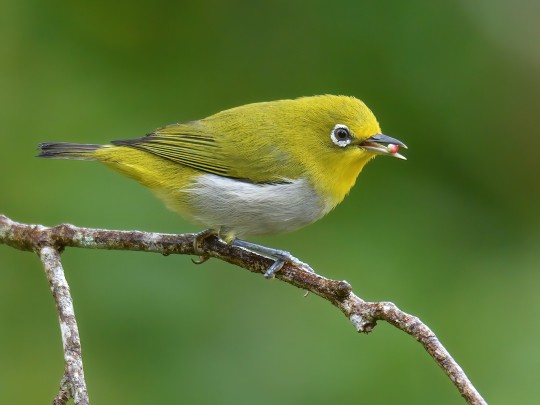
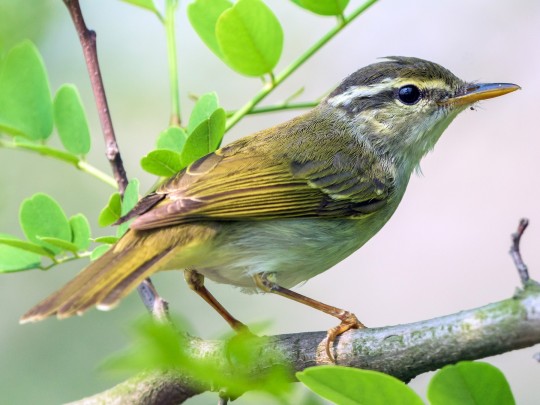
These three have far less detailed models, so their species are more educated guesses than perfect identifications.
From left to right:
Red-flanked Bluetail Tarsiger cyanurus (I am very confident about this one)
Warbling White-eye Zosterops japonicus (I am reasonably confident about
this one)
Eastern Crowned Warbler Phylloscopus coronatus (this is a very educated guess)
And finally we have the last bird, number 13, and i have no idea what the hell it is supposed to be.
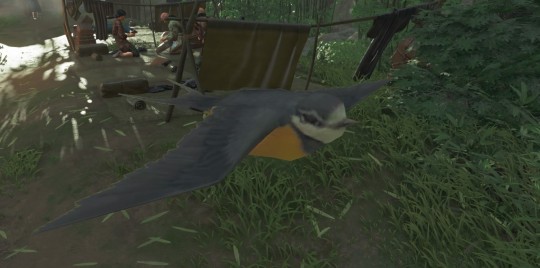
-yellow swallow- what the fuck are you?
This enigma can be found in several places including Senseo, NW Izuhara near coast, and SW of Numata Settlement. I don't know what it is. It looks like it shares a model with the Pacific Swallow with the coloration of a juvenile Blue Tit. I would appreciate any and all suggestions for what it possibly could be.
And thats the Birds of Tsushima! I plan to do several more of these type of posts for various fictional birds from all sorts of media, so come and follow if you would like to see them. I will be tagging this series #birds of the fictional world as well #bfw(my general works tag)
And if you have any good medias for me to look at birds in, send me an ask! I would love to hear about them!
11 notes
·
View notes
Note
thoights on the accipiter breakup
i assume this is about the astur/accipiter split and honestly im ambivalent towards it, agos/eugo and coha make sense to split, though i need to recheck what else is being reorged
anyway in the process of checking ive realized wikipedia for some reason has a picture of a RTHA in the gundlanchs hawk row and its like midnight so my brain went "damn they put buteos in this too? taxonomy is crazy now" for like an entire second
but yeah i need to actually like. read about it more
also i stand by this thing i said

also-also the way this was phrased also makes me think of either 1) influencer breakup i hear about third hand 2) indie band drama
13 notes
·
View notes